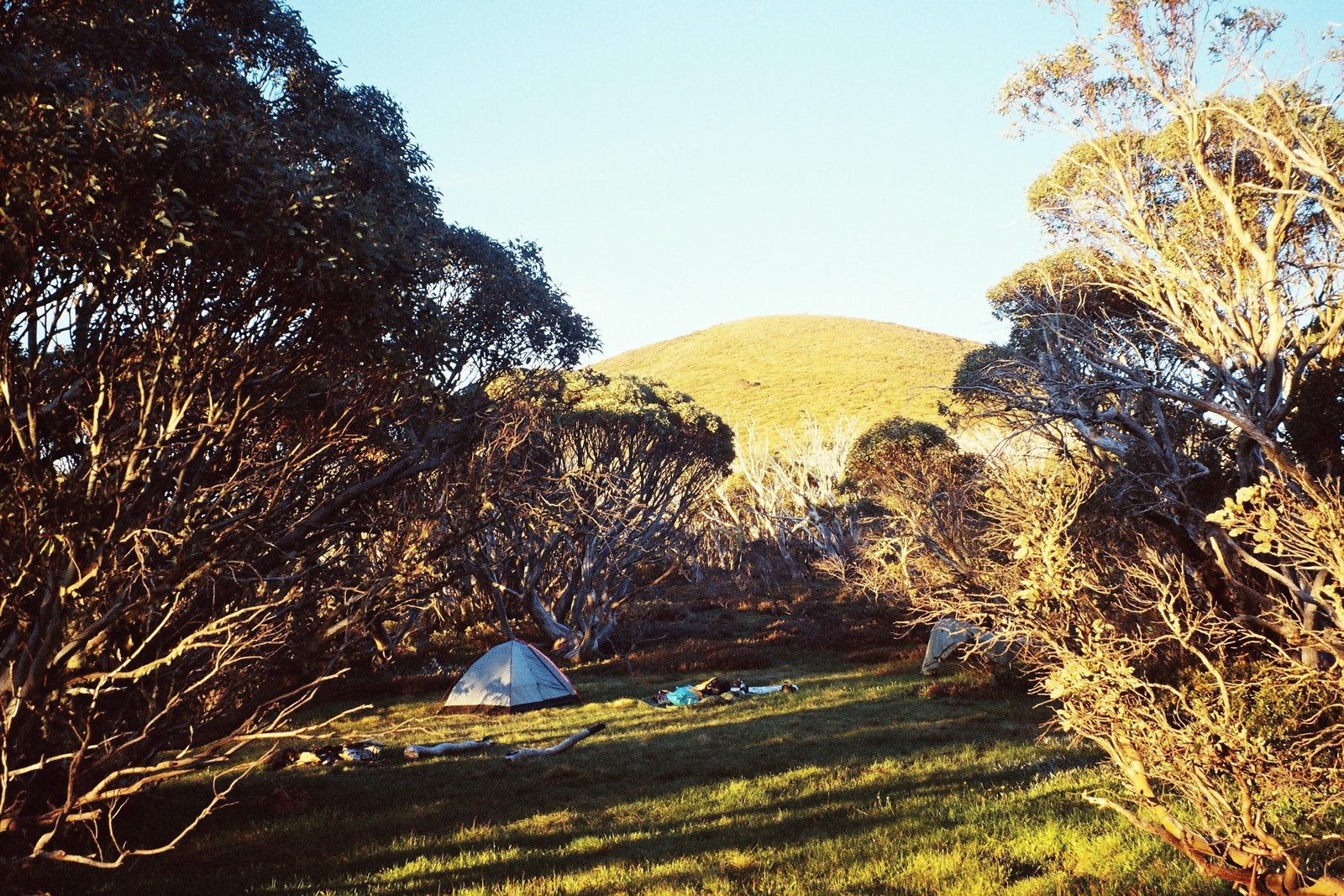Mt Feathertop: history, huts and hikes
The classic winter view of Mt Feathertop from Mt Hotham ski resort.
© David Sisson
Mt Feathertop is the second highest mountain in Victoria and one of the most picturesque peaks in the state. It is joined to nearby Mt Hotham by The Razorback, a high narrow ridge, but is otherwise surrounded by steep slopes. It has a sharply defined summit ridge rather than the rounded domes of many nearby peaks.
In the 19th and early 20th centuries the mountain hosted gold mines and mountain cattlemen, but as the gold ran out, the activity it provided on Feathertop was replaced by tourism. The Feathertop Bungalow operated as a commercial ski lodge from 1925 to 1939 and the mountain almost became a major ski resort. Today it has reverted to a relatively isolated and undeveloped peak with only two refuge huts.
In addition to the history, brief descriptions of eight walking routes on Mt Feathertop are included, they can be found in section 8 of this article. Finally this is a long article, with around 25,000 words and 60 illustrations when I last checked, so while it's designed to be phone friendly, it is best read on a computer or large format tablet.
The classic view of Mt Feathertop in winter. 1930 Kath Magill.
© David Sisson. 2015 - 2018.
The summit ridge in summer viewed from the Razorback. Photo: © Blair Hamilton.
Contents
The Feathertop Bungalow in 1935. Photo: Mick Hull.
Click on main chapter headings to go to that section.
1. Mt. Feathertop: naming, mining and grazing
- Gold mining
- Mountain cattlemen3. Early days of the Feathertop Bungalow
- Planning and construction
- Opening and operation
- Difficulties with land tenure4. The last decade of the Bungalow
- Transport
- Skiing
- Destruction5. Post war events and proposals
- Feathertop is overtaken by other ski destinations
- Tracks and management
- Walking track development
- Management
- The Cross
- Three development proposals
Hydro electric plans
A chairlift for Feathertop
Razorback railway station6. Huts
- Feathertop Hut
- Razorback Hut
- MUMC Hut
- Old Federation Hut
- New Federation Hut
- Proposed High Knob huts8. Hiking routes on Mt Feathertop
- Winter access
Appendices. Historic documents on Mt Feathertop
9. Feathertop buildings in 1936. Cleve Cole & Roy Weston
10. Feathertop Bungalow documents
- The Chalet at Feathertop. Gordon Langridge
- The opening of the Feathertop Bungalow
- 1928 arrangements for the Bungalow
- Ada Banks, manager of the Bungalow
- The Bungalow on Feathertop. Bob Croll
11. Articles from the 1920s
- Feathertop Snow Carnival 1923. F. Barker
- Scaling Feathertop & crossing the Razorback 1926. J. Tulloch13. MUMC Hut documents
- Description of hut design. Peter Kneen
- Building the MUMC Memorial Hut. Phil Waring
1. Mt. Feathertop: naming, mining and grazing
Mt Feathertop from the Bogong High Plains in the 1920s. Photo Robert 'Wilkle' Wilkinson. Source National Library of Australia.
Mt Feathertop was sighted and named in early 1851 by Jim Brown and Jack Wells, stockmen from Cobungra Station. While looking for summer pastures they became the first non aboriginals to systematically explore and name locations around the Bogong High Plains. They named the mountain after the feather shaped plume of cloud that is often seen downwind from the summit. They dubbed nearby Mt Hotham 'Baldy'.
The mountain was first climbed in 1854 by explorer and Government Botanist, Dr Ferdinand Mueller (from 1871, Baron Ferdinand von Mueller), who was unaware that the name Feathertop was already in use by cattlemen and gold prospectors. He suggested that it be named Mt Hotham after Victoria's newly appointed governor.
Mt Feathertop from the Ovens Valley goldfields in 1863. Lithograph from an original by Nicholas Chevalier
Graziers took up runs in the upper Ovens valley in the late 1830s. However the area was fairly sparsely settled before the gold rush. Gold was found near the base of the mountain at Harrietville as early as 1852, but the big rushes were at nearby Wandiligong and the Buckland Valley. The prospectors and miners naturally picked up the names used by local farmers and pastoralists. As farms were established and the area became more closely settled, these names stuck and titles given by von Mueller and later surveyors have, with a few exceptions, vanished. However the name Hotham was transferred to the peak we now know by that name. The original cattlemen's name for the peak 'Baldy' survived in Little Baldy, a nearby hill that was never renamed Little Hotham.
Ore bin at the Razorback mine.
Gold mining
Mining occurred on the slopes of Feathertop from the 1870s to the mid 20th century. The Champion Reefs on the spur of the same name were mined from 1868 to 1874 producing 1,927 troy ounces (60 kg), before the gold ran out. Attempts to revive the mine were made from 1920 - 1925 and in 1945, but no more gold was produced.
The Razorback Mine operated intermittently on the Razorback from 1895 to 1903. It was about 1½ km south of where Champion Spur joins the Razorback; remnants were visible after the 2003 fires. Another mine on the Razorback was operated by The Government Grant and Birthday Gold Mining Co. which in 1895 built a large water powered crushing battery with a 1 km inclined tramway connecting it to the mine. But the ore did not live up to forecasts and it only produced 55 ounces (1.71 kg) before being abandoned in 1897. Tribute parties mined a little more before the mine and battery were burned by wildfires in 1906. (Tribute mining was an arrangement where the owner of an unused mine allowed independent parties to extract ore in return for a percentage of the proceeds.)
Battery used to crush ore at the Razorback Mine. Photo from Alpine Shire history
More information on mining can be found in: Brian Lloyd's. Gold at Harrietville. Shoestring Press, 1982. Also worth a look is Andrew Swift's Beneath the Razorback, a DVD on the history of mining on the Razorback with visits to locations to the sites of mines, batteries and relics. It is available from Heritage Rat Productions.
Lawler family cattlemen on Feathertop, probably early 1930s.
Mountain cattlemen
Graziers found things harder on Mt Feathertop than on nearby mountains, the steep slopes made grazing and mustering difficult. Nevertheless after summer grazing runs had been taken up on the gently graded Dargo High Plains, farmers looking for new summer pastures ventured on to Mt Feathertop. Cattlemen active on Feathertop included John Howard and many members of the Lawler family who droved cattle from their property on Snowy Creek at Freeburgh, up Dungey's Track to the North Razorback, over a rough pad to the west of the summit and on to Mt Hotham. Their yards were in Corral Saddle between Mount Hotham and Mt Higginbotham, near the modern Corral car park.
From the mid 1920s, 'run 29' in the area around the top of Bungalow Spur was held by Jack Keating. He had a property near Harrietville which was connected to his run by a good track up Bungalow Spur. With Feathertop Hut providing shelter, in contrast to other Feathertop cattlemen, Keating had a fairly easy muster of his cattle.
Boundary of Feathertop grazing run from an unpublished paper by Peter Cabena for the Lands Department. Mount Hotham: its history from the 1850s to 1950s, 1979.
While Razorback and Feathertop huts were used by mountain cattlemen, it appears that no huts were built by them on Feathertop. The Lawler family conducted their operations from their huts at Stony Tops at the far north end of the Razorback, Snake Valley (the West Kiewa River) and at Mt Hotham. Feathertop's steep slopes meant that grazing was never an easy proposition after concerns about soil erosion were raised, grazing leases were withdrawn in 1958. The affected cattlemen were mostly compensated with leases elsewhere. It appears that limited grazing continued on parts of the Razorback until 1978 although it is fairly certain that cattle were excluded from the mountain itself.
The boundaries of the Feathertop run were fairly fluid and it was sometimes split between two parties, but it usually included the north and south Razorback in addition to the mountain itself. The lease holders were:
1888 - 1893. John Evans of Laceby, near Wangaratta
1897 - 1908. Jack Lawler of Freeburgh
1905 - 1909. Jack Lawler, Freeburgh
1908 - 1931. Charles Howard, Harrietville
1931 - 1939. Victor Lawler, Freeburgh
1939 - 1945. Vic Lawler & Jack Keating, Harrietville
1945 - 1978. Vic Lawler, J. Keating & Bernard Lawler
Advertisement in The Herald. Saturday 12 January 1889, p. 1.
2. Early tourism and skiing on Feathertop
As soon as the railway to Bright was completed, locals began promoting the mountain attractions of the area to capture a share of the lucrative tourist trade. The first winter ascent of Mt Featherop was made by members of the Bright Alpine Club led by A. H. Sharpe and Don Gow in September 1889. They used ropes and wore snow shoes, not crampons or skis.
Climbers and dog. Mt Feathertop 25/8/1911. Photo prob by either R. M. Bowie or Jim Tobias
The first skiing on the Razorback was in either 1900 or 1902 (sources differ) when brothers Harry and Peter Petersen skied from their mine on Mt Tabletop, near the modern town of Dinner Plain, to Harrietville via the Bon Accord Spur. At the southern end of the Razorback, Peter triggered an avalanche when a cornice collapsed beneath him. He was uninjured, but lost a ski and the exhausted brothers arrived at Harrietville well after dark. The first full crossing of the Razorback on skis was by pioneer skier R. W. Wilkinson accompanied by the Norwegian consul, Hans Fey in 1912. They apparently traversed the Razorback from the Great Alpine Road right to the top of Feathertop in just 3 hours, an impressive time even with today's equipment.
In 1906, at the instigation of Jim Tobias and the Harrietville Progress Society, a rough track to the mountain from Harrietville was cut which ran close to the present Bungalow Spur track. A 'shelter shed' was also built near a spring on a flat area near the treeline, but in 1912 it was replaced by Feathertop Hut (see chapter 6). The hut was mainly used as a base for summer excursions, but was occasionally used for climbing and snow walks.
Late in 1919 the nearby Buffalo Chalet was leased by the Norwegian born Hilda Samsing. She put considerable effort into promoting Mt Buffalo as a winter destination and imported skis to hire to guests. This was probably the greatest stimulus that led to the explosion of interest in skiing in the 1920s.
Early skiers on Mt Feathertop, possibly at the 1923 carnival. Photo: Robert Macedon O'Brien. Source State Library of Victoria.
On 10 August 1923, a "Snow Carnival and Ski-ing Championship" was held on Mt Feathertop. On the day 100 horses and 150 pedestrians climbed up from Harrietville.
Organised by the Harrietville and Bright Progress Associations. Ideal day, fine and clear. Over 100 horses and many pedestrians left Harrietville between 7.00 and 8.00 am for the scene of the sports, where every preparation had been made for the comfort of the visitors. The only building on the mount was a shelter shed erected by the Progress Association and consequently visitors had to be content with a picnic in the snow. After partaking of refreshments, a start was made for the skiing ground, where a course of 800 yards had been marked off and flagged. Among the events was a dish race, in which ten starters each sat in a large dish, and one can imagine as they gathered speed, the heat which would be generated by these dishes in their spinning career down the slope. Spills were numerous and seats of trousers suffered...
Sadly, the spectacular sport of dish racing never became as popular as it deserved to be. While Feathertop Hut was the only structure on the mountain, the success of the carnival planted an idea in the minds of some entrepreneurial skiers and a nearby hotel manager who was about to lose her lease.
3. Early days of the Feathertop Bungalow
Members of a 'Skyline' package riding tour at the Feathertop Bungalow, circa 1929. Photo: W. Howieson. Source: State Library of Victoria.
Planning and construction
In 1925 the Feathertop Bungalow was built by a syndicate led by Gordon Langridge, one of the pioneers of skiing in Victoria in the years after the First World War. He was in the first group to ski on Mt Buller, was an early skier on the Bogong High Plains and was founding president of three clubs: the Ski Club of Victoria (1924), the Chamois Ski Club (1925) and the Mt Buffalo Alpine Club (1927). In later life he remained a keen skier and in 1947 was involved in establishing the Federation of Victorian Ski Clubs (which became the Victorian Snowsports Association).
Ad for the Buffalo Chalet which appears to be from the time it was run by Hilda Samsing
The other driving force behind the Bungalow was Hilda Samsing. Norwegian born Samsing was a decorated nurse in the First World War and was reputedly the only woman to go ashore during the Gallipoli campaign.* On her return to Australia, she held the lease of the Buffalo Chalet from 1919 to 1924 for a fee of £800 per year. The Buffalo Chalet had become run down under the former management and complaints about the standard of accommodation were not unusual. So Samsing thoroughly renovated the building, installed new furniture and began to promote it as both a summer and winter destination. Occupancy soon took off and the Chalet became rather profitable. But perhaps she was too good at her job because in late 1924 she lost the lease to the Victorian Railways, who took over as the new landlords of the Buffalo Chalet. Samsing was compensated £4863 for the 'plant and equipment' she left behind at Buffalo. She was keen to stay in the ski accommodation industry and readily accepted Langridge's approach for her to join the syndicate. According to The Herald, she took a break in Europe in early 1925 and had a look at snow tourism on the Continent.
There are two other women who may have gone ashore at Gallipoli, both to possibly visit the grave of Lt Col Charles Doughty-Wylie VC. One was his wife Lilian Doughty-Wylie, a nurse and philanthropist, the other was his friend and possible lover Gertrude Bell, a well known anthropologist and diplomat.
Bungalow co-founder Hilda Samsing as a nurse in the First World War.
The Feathertop Bungalow was intended to be a minor forerunner of a huge project over ten times larger. It was to include a 300 bed chalet and international standard ski jump, for a total cost of £80,000, an enormous sum for the time and if capital could be raised,it was hoped to commence building in the summer of 1925 - 1926. The syndicate was planning a complex much bigger and better than the Buffalo Chalet with a road, walking tracks and extensive ski runs. The railways were reported as welcoming the planned project but they would hardly have declared that they would do their utmost to to squash this new competition; but more on this later. If the full proposal had gone ahead, it is probable that Feathertop would have developed into Australia’s premier ski mountain.
So with the most enthusiastic skier and the most dynamic ski industry business person of the day on the board, the company looked well placed to thrive in the rapidly growing new sport. The first visible action of the nascent company was to upgrade the rough walking track from Harrietville up what would become known as Bungalow Spur to a well graded pack-horse bridle track to allow building materials to be delivered. By the 1930s the track was being used by oversnow tractors.
The Bungalow was prefabricated in Malvern Road, Prahran by Davies & Co. and transported by train from Malvern station to Bright and then by road to Harrietville. Six sleds, each pulled by six horses, moved the sections from Harrietville to the building site where it took three weeks for seven carpenters, two plumbers and six labourers to erect it. Tor Holth interviewed mountain cattleman Billy Howard on his experience of transporting corrugated iron to the Bungalow on pack horses. '[there were] about seven to eight foot sheets and we rolled them in a half moon with straps around and they went up over the horses neck and just about, scratched the ground. I used to do two trips a day. I had two packhorses. My father had the sleigh and he'd be flat out doing one - he had a heck of a job. It was a well-made sleigh with two runners. It was five miles and a reasonably good track.'
The outside walls of the Bungalow were utilitarian corrugated iron while the inside was lined with tongue in groove wood. There were eight bedrooms with four beds in each, (although later the bunks were removed from some rooms and were replaced with two single beds). The Bungalow also had a large dining and lounge room equipped with a gramophone, two bathrooms and a kitchen. The building featured electric lighting and while hot water was not provided initially, a hot water service was installed later to replace the need to heat bath water on the stove. However the Bungalow didn't have a septic tank and two outdoor toilets were positioned on the edge of a cliff above an understandably fertile valley.
Feathertop Bungalow without the northern annexe. Photo from Matt Guggisberg's site.
Opening and operation
After fit out and delivery of 50 pairs of Norwegian skis, the Feathertop Bungalow opened for business on 13th July 1925 with a display of fireworks in the evening. The total cost was £3,000. It is impossible to provide a relative price in today's money, but the original Buffalo Chalet (before extensions) had cost £7,000 when it was built 15 years earlier.
The Feathertop Bungalow in summer. Photo: Harrietville Historical Society.
The Bungalow was well patronised and popular, members of several ski clubs including the Ski Club of Victoria regularly stayed there, (despite an apparent dispute Langridge had with the SCV which had led to him resigning his presidency and establishing Chamois Ski Club). At least one school hired the Bungalow as it is recorded that 20 Scotch College boys stayed there in August 1927. Hilda Samsing was the resident manager in winter, while a caretaker looked after the building and guests in summer. Samsing's widowed sister in law, Hannah Samsing dealt with the accounts.
Difficulties with land tenure
The Bungalow was built on Crown land but the owners had gambled on speeding up construction by building on a miner's right, rather than waiting for approval from the Lands Department for a long term lease or waiting even longer to buy the land. During the later years of the gold rush, it became fairly common practice for people wishing to settle in an area to peg residential sites under a miner's right rather than wait for the slow moving bureaucracy to grant a more permanent form of tenure. While this loophole still existed 60 years later, by the 1920s it was rarely used and easily revoked, especially if the residents made no attempt to mine the land.
It appears that the syndicate were confident that they would get tenure of their land without much difficulty. But the Lands Department delayed making a decision and decided to consult widely on the issue. Langridge later wrote that he believed certain bureaucrats deliberately obstructed the owners of the Bungalow in their attempts to obtain a 50 year lease. The railways, who were now the operators of the Buffalo Chalet, had forced the other two accommodation houses on the Buffalo Plateau to close and also did their best to thwart this new competitor. One of their tactics was to argue that this previously unknown mountain was a tourist area, so any developments should be built to a high standard and if the rather basic Bungalow wasn't upgraded within seven years, the railways should have the option to take it over. The Minister of Lands, (either A. Downward or H. S. Bailey) reportedly disagreed with the railways, seeing their proposal as far too restrictive and it appears he favoured granting a 21 year lease. And thus the status of the Bungalow became stuck in bureaucratic limbo with the railways having the influence to block any proposed resolution.
By late 1927 it became obvious that no lease would be granted and the owners salvaged what they could by selling the profitable Bungalow to the railways in June 1928 for a bargain £250, only 8% of what it had cost to build. (Although one source says the sale price was £450.)
There are interesting parallels between the Feathertop Bungalow and the Buller Chalet as they were very similar projects. The Buller Chalet was built in 1929 by a syndicate of skiers and Mansfield people. It only slept 14 when first built, but had grown to accommodate over five times that number within a decade. At a time when few people owned cars, both the Bungalow and the Buller Chalet were a similar distance from a rail head and both were accessed by road and then a well graded bridle track. Both had similar facilities. Of course after the experience of the Bungalow's land tenure, the builders of the Buller Chalet made sure they had a secure lease on their land. Despite the economic hardship of the Great Depression, the Buller Chalet was a huge success and was extended to 32 beds in 1932 and between 67 and 80 beds in 1939 (sources differ on its final capacity). It escaped the 1939 fires, but was destroyed in 1942 when a burning log spilled out of an unattended fireplace. It is interesting to speculate if Mt Feathertop would have developed in the same way as Mt Buller if the visionaries who built the Bungalow had managed to get a secure lease or to buy the land.
The Ladies Slalom Course off Little Feathertop in 1937. Federation Hut is now at the base of the hill in the centre of the picture. Photo by Gerard Wardell. Source: State Library of Victoria
Marjorie Good (later Leviny) and friend at the Bungalow before embarking with Kit Moore on the first women's winter crossing of the Razorback from Feathertop to Hotham Heights.
Photo Harrietville Museum.
4. The last decade of the Bungalow
Before the railways realised the potential of the Bungalow and appointed a manager, conditions were more basic than they had been earlier. There had been controversy when Harold Clapp, the railways' commissioner, had bought the Bungalow, despite opposition from senior figures in the railways and state government, so things may have been deliberately kept low key until the fuss died down. It's unclear how actively the railways managed their new acquisition during the first two years of their ownership, but ski groups are recorded staying there 1928. Experienced ski tourer Marjorie Good (later Leviny) reported that conditions at the Bungalow in the 1929 ski season were 'terribly, terribly rough'.
This decline of the Bungalow was soon reversed. From 1930 to 1934 Ada Banks was employed as manager for a generous £7 a week. This was almost double the average wage at the time, so the £7 may have included allowances for other operational expenses such as laundry. Her duties included riding up to the Bungalow to deliver perishables such as meat, cleaning it prior to guests arrival and cooking for them during their stay.
In later years the Bungalow was staffed in winter and peak summer periods. Groups such as the Wangaratta Ski Club and the University Ski Club often hired the entire Bungalow for a week and contrary to some published claims that the Bungalow was abandoned, it was usually full in winter and got plenty of business in summer.
Managers of the Bungalow when it was owned by the railways were: Ada Banks 1930 - 1934, Jim and Pearl Bradshaw 1935 - 1936, Mr and Mrs H. Richards 1937 - 1938, Mr and Mrs Marshall 1938 - 1939. In addition, the railways employed Alf Rosner for a year in some role at the Bungalow in the late 1920's possibly as a cook or a handyman.
The Feathertop Bungalow in 1931. Photo Alan Brockhoff.
After managing the Feathertop Bungalow for two years, Jim and Pearl Bradshaw moved to Hotham Heights which the railways had recently acquired. They successfully managed it from 1937 to 1946, seeing it rebuilt after the 1939 fires and running it through the Second World War. They got on well with Bill Spargo, the former lessee of Hotham Heights, who became a full time prospector, hiring him for occasional work to supplement his modest mining income. To everyone's surprise, Spargo eventually discovered a rich gold deposit near Hotham and the Red Robin mine made the impoverished prospector a wealthy man.
Strip ticket for a package of transport and accommodation at Harrietville Museum. Photo Ronice Goebel.
A newspaper article infers that Spargo gave Jim Bradshaw a share of the claim: 'I advised Mt Bradshaw... to take a share. He had been a good neighbour to me, and my chance came to do him a good turn.' However Stephen Whiteside, who interviewed Pearl Bradshaw in 1987 and 1988 says that Pearl asserted they never made any money from the Red Robin and he believes that instead Spargo may have given Jim Bradshaw the nearby One Alone mine which Spargo had worked sporadically but which never paid more than expenses. In any case, after 12 years of running isolated ski lodges, in 1947 the Bradshaws had the money to acquire a servo in South Melbourne before changing to a cafe a few years later. They were probably the only people associated with the Bungalow to do well financially from running ski lodges.
When the railways took over the lease of the Buffalo Chalet, they bought some of their corporate culture with them. One aspect of that was the use of tickets for activities, ski hire, transport and accommodation. After they acquired the Feathertop Bungalow and began to take it seriously, the use of tickets was also introduced there. The photo shows a strip ticket with detachable coupons for a package deal of accommodation and three modes of transport. While it appears that most of the railways package deals for transport and accommodation at the Bungalow included first class rail travel, the accommodation wasn’t close to first class standards, even by the modest standards of the 1930s.
As the 1930s progressed, the railways gradually improved services. From 1936, Eric Stewart was employed by the railways as a 'snowline representative' to escort guests to Hotham Heights and the Feathertop Bungalow. In 1936 the Austrian ski instructor Franz Skardarasy taught at Feathertop and Hotham, although his main base was at Buffalo. By the late 1930s ski instructors were based at all three of the railways' ski lodges. The Buffalo Chalet and Hotham Heights got Austrian instructors, but guests at the Feathertop Bungalow had to make do with a local. The 1939 Ski Yearbook reported that Freddie Pryce Jones was the Feathertop ski instructor in 1938.
Under the control of the railways, Feathertop was mainly marketed to intermediate skiers, those who had graduated beyond what was available at Mt Buffalo or Donna Buang, but who were not ready for Mt Hotham which was difficult to access in winter and sold as a ski destination for experts. Typical of the coverage Mt Feathertop received is this extract from a long article on skiing in Victoria published in the weekly social newspaper Table Talk.
Feathertop Good for the Tyro
FEATHERTOP is attractive to beginners as the bungalow is built about four miles above Harrietville, and it is a pleasant walk up the timbered track—especially if you are wise enough to put your skis and pack on a horse. There are gentle slopes close to the Bungalow where the learner can find his ski legs. Then after a few days practice there is a pleasant trip to Mt. Feathertop, about a mile away, and the hours will go quickly as you negotiate the steeper slopes at the foot of the mountain. Table Talk. 11 June 1936. pp. 16 - 17.
Sign at Wangaratta station listing three branch lines in the area and showing the railways three ski lodges in the pre war years. The railways did not control the St Bernard Hospice and it is absent from the list. Photo: © Peter Dwyer. Used with permission.
Transport
After many delays the railway to Bright opened in 1890. A rough survey was done for an extension to Harrietville with the terminus planned to be behind the school. But the economic depression of the 1890s put an end to any hopes of the line heading further up the Ovens Valley, so Bright remained the railhead for the area until the line closed in 1983.
When the Razorback hosted gold mines in the late 19th century, huge machinery such as steam engine boilers, stamping batteries and water wheels were somehow dragged up the slopes of Mt Feathertop on drays drawn by bullocks or horses. Teamsters such as George Sealey used pulleys and winches to assist their animals in hauling machinery and supplies up to the Razorback and Champion mines.
The 20th century saw tourism take over as the main activity on Mt Feathertop. In the 1920s and 30s many main roads were still gravel and by today's standards, cars were uncomfortable and unreliable. So most visitors to Feathertop caught the train along the Ovens Valley to the terminus at Bright where they transferred to hire cars for the final part of the journey to Harrietville.
By 1937 express trains on the north east main line from Melbourne to Albury traveled at much the same speed as they do today. But other trains stopped more frequently and were much slower, especially trains on lightly built branch lines. So most travel was at a far more 'leisurely' pace than today. Roads were poor, cars often unreliable and there was no real competition from airlines, thus there was no great pressure for the railways to speed things up.
Bright railway station in the 1920s. It was here where guests bound for the Feathertop Bungalow transfered to cars for the trip to Harrietville.
In the 1930s guests staying at the Bungalow would usually leave Melbourne at 4.00 pm on Friday, take dinner at the Wangaratta station refreshment rooms before departing on the Bright 'mixed' train (which hauled passenger and freight carriages) at 8.30 pm, arriving at Bright after 10.00 pm. They would either stay the night at Bright or travel to Harrietville by road before ascending Bungalow Spur on Saturday morning. On other days, an 8.00 am departure from Melbourne was required in order to connect with the daily mixed train which departed Wangaratta at 1.00 pm. After shunting trucks at intermediate stations, the train arrived at Bright at 3.15 in the afternoon.
A pack horse being unloaded by Frank Wraith near the Bungalow. Jim Bradshaw, manager of the Bungalow is at the back.
From Harrietville guests headed for Feathertop took the bridle track built in early 1925 to transport construction material for the Bungalow. They had a choice of walking or hiring a horse for 5/-, but most chose a middle option of walking and using a pack horse to carry their luggage. In light snow the horses could get all the way to the Bungalow, but in heavier conditions they were unloaded lower down the mountain. After the horses were unloaded, their reins were tied and they found their own way back to Harrietville.
Kath Magill and friend at the Bungalow. August 1936.
The end of the Bungalow did not mean the end of the pack horse on Feathertop and in the 1940s Eric Johnson Gravbrot packed supplies for visitors staying at Feathertop Hut.
While the track was gradually widened and improved to allow oversnow tractors to reach the Bungalow, it was never a true road. At the time roads were built with steam powered excavators, horse drawn dirt scoops and a great deal of manual labour, so building mountain roads was especially expensive. This changed in 1938 when the Kiewa Hydro Electric Scheme used the first bulldozer in Victoria to build the road from Tawonga in the Kiewa Valley up to the Bogong High Plains. While the advent of bulldozers made building mountain roads more affordable, the loss of the Bungalow in January 1939 and the outbreak of the Second World War seven months later, meant that any dreams of a road up Feathertop were never realised.
After the war many 4WD roads were built in the high country, but except for a few fire access tracks, roads were always built to serve an economic purpose such as hydro electricity, timber harvesting or tourism. In 1954 the Bright Shire was pressing for a road to be built on Mt Feathertop, but they were apparently looking for finance from state government authorities and it is unlikely they had the money to build it themselves.
While a few logging roads were built lower on the mountain, there was no reason to extend them beyond the middle slopes. In the 1970s some alarmist stories were put out about proposed roads along the (southern) Razorback or up Bungalow Spur, but it appears that constructing them was never seriously considered. The cost couldn't be justified as the Bungalow was long gone and very few stands of timber would be accessible from roads on those routes. To practical country people such as the cash-strapped local shire and logging contractors, it didn't require an elaborate cost-benefit study to determine that such roads wouldn't be of much use to the locals, nor would a road on Feathertop earn much income for whoever built it.
Cletrac oversnow tractor at the Bungalow. Similar machines worked at the Buffalo Chalet. Photo: Harrietville Historical Society.
Undated photo of Cletrac tractor hauling firewood to the Bungalow without the north wing
Skiing
There was some clearing of ski runs on Feathertop and as the railways began to realise the potential of the Bungalow and the mountain, a few more ski runs were cut in 1934, but the treeline was a little lower in those days. No ski lifts were ever built, although the Wangaratta Ski Club built a ski jump in 1938. As it had easier access, many skiers before the Second World War considered Feathertop more suited to intermediate skiers with Hotham better suited to experts due to the perilous crossing from Mt St Bernard along the Great Alpine Road where no attempts were made to clear the road of snow until 1957.
In the pre war years there were over 20 active ski clubs in Victoria and many held races on Feathertop, including the 1929 Ski Club of Victoria championships and a number of Wangaratta Ski Club contests, although the mountain never hosted the national championships. Before 1955, it was impossible to actually hold proper state championships as one larger club, the Ski Club of Victoria, refused to acknowledge the legitimacy of other ski clubs and would not race against their members.
Two photos show an apparently smaller Bungalow without the northern section, my guess is that this wing was probably a storeroom with accommodation for staff. It is not known if this was part of the original building or added later and I have not found any written material on the subject.
Ski runs below the treeline on Bungalow Spur 1934. Photo K. Magill.
It is possible that the building may have been built with the northern wing, which was later demolished, or that it was an extension added to the original building at a later time. Two photos dated 1929 and 1935 show the northern wing, so modification to the building must have happened in either the first four or last four years of its existence. The presence of a Cletrac tractor in one of those photos without the northern wing suggests that the extension or demolition took place after the railways assumed ownership as they also ran Cletracs at Mt Buffalo from the late 1920s to the 1940s and it would have been fairly easy to transfer one to Feathertop.
Destruction
The Black Friday Fires of 13 January 1939 were the biggest the state has ever seen and consumed Razorback Hut, the first Bon Accord Hut, and the Bungalow. The old Feathertop Hut was spared.
Feathertop from The Playground. 1934 Photo Kath Magill.
No Bungalow for Feathertop!
Feathertop seems to have been temporarily eclipsed as a ski-ing resort. The railways have no intention of re-building the Bungalow there, burnt in the January 1939, bush-fires, and do not intend to play any part in the future development of Feathertop.
The Bungalow there was always a popular place for beginners and those not so well-equipped by nature for the longer trip to Hotham, The well-graded track from Harrietville is easy to follow, protected all the way and horses could reach the Bungalow in all but exceptional conditions, a feature especially attractive to the uninitiated and one which also eliminated the need for packing in a good deal of the food supply in preserved form during the summer, and sledging fresh meat during the winter. [This was how lodges at Mt Hotham were provisioned from 1925 to 1958.]
The Feathertop Bungalow site in 2005. Photo: © David Sisson.
Slopes are better than at St. Bernard, both for beginners and for those more advanced. Here is an opportunity for the S.C.V. or Wangaratta S.C. to make more liveable the present hut near the Bungalow site, with the permission of the owners, the Harrietville Progress Association. Better still would be to re-build it nearer Little Feathertop, where there are some good southern slopes. There will always be a demand for such a hut, as without it the Razorback trip is not safe. The future may give it additional uses, as Tony Walch was keen to try the slopes of Big Feathertop for late spring ski-ing. The present hut has bunks for six.
Despite a recommendation from the S.C.V., the State Tourist Committee has not yet seen fit to put a pole-line across the Razorback from Feathertop to Bon Accord. Except [for] the Fainter traverse, this is the last remaining high-level route which is used frequently enough to warrant such expenditure, and it is to be hoped that something will be done as soon as the war is over. The trip can be a delightful one on a good day, but the route is very susceptible to fogs and sudden changes of weather, and the loss of the half-way hut (1939 bush-fires) renders the trip doubly difficult in these conditions.
Australian and New Zealand Ski Year Book 1941. p. 52.
The outbreak of the Second World War, seven months after the Bungalow was burnt prevented any reconstruction, but in 1946 the Wangaratta Ski Club took out a permissive occupancy lease on the site of the Bungalow with a view to building a lodge on Feathertop to complement their new (1946) lodge near Mt St Bernard. They were still considering building on the site in 1956, but let this option lapse some time later. This was the last realistic chance to reconstruct the Bungalow. Sadly, rebuilding the Bungalow would be 'politically impossible' today, too many people would find too many reasons to object.
Between 1925 and 1932 the Victorian Railways took over three ski lodges in the Bright area from previous operators and often promoted them together. Mt Buffalo Chalet. the largest and most comfortable, was marketed as suitable for novices, the Feathertop Bungalow for intermediate skiers and Hotham Heights was sold as a destination for experts. Staff such as Skardarasy were sometimes shifted between locations over the winter. Advertisement from Table Talk. 4 June 1936. p. 31.
Signpost to Hotham – approach to Feathertop summit. located where the Razorback meets Bungalow Spur. Photo W. H. Jemison, October 1950. © High Country Online. Used with permission.
5. Post war events and proposals
Feathertop is overtaken by other ski destinations
After the war ended in 1945, lodges were quickly built at Mt Buller and Mt Hotham which began to develop into modern ski resorts. They were joined by Falls Creek in the late 1940s and Baw Baw in the early 1960s. While Mt Buffalo trundled along under railways management without much change until the mid 1960s, two pre war ski destinations were eclipsed. One was Donna Buang, Victoria's busiest ski resort before the war. From the late 1940s its popularity shrank rapidly and it had been completely deserted by skiers by 1953.
Mt Feathertop was the second ski destination to disappear from the awareness of skiers. By 1950 there were two dozen lodges either built or under construction at Buller while Hotham had five lodges, two ski huts and another lodge nearby at Mt St Bernard. Falls Creek had four lodges with many more planned. This post war explosion of activity consumed the attention of skiers and the new ski lodges provided comfortable bases for skiers to explore nearby mountains. But without the Bungalow or anything other than an increasingly run down hut, Mt Feathertop could not compete effectively for the attention of skiers.
The October 1951 issue of Ski Horizon magazine has a glowing report on skiing on Mt Feathertop, but the author was amazed that during the whole ski season of that year, just two groups had booked Feathertop Hut, the only surviving building on the mountain. That article appears to be the last that treated Feathertop as a mainstream ski destination, from then on it seems to have been viewed as just another remote mountain only visited by backcountry skiers, climbers and hikers.
Hikers on Feathertop, spring 1962. © Margaret King. Used with permission
Tracks and management
Walking track development
In the 1930s, after the mining tracks became overgrown. the only properly built track on the mountain was the track to the Feathertop Bungalow, although generations of mountain cattlemen droving cattle along the full length of The Razorback from Stony Tops to Mt Hotham had created a cattle-pad on that route. It seems there was also a foot-pad up Diamantina Spur in the 1930s. Work was begun on a track up North West Spur in 1965 by the Melbourne University Mountaineering Club during planning for their hut. However track building on the spur was suspended when the access route for hut construction was shifted to the old droving route along the North Razorback, with the North West Spur track finally being completed in the late 1960s.
While snow pole lines were installed on the Bogong High Plains and Mt Hotham during the mining era of the late 19th century and renewed for skiers and hikers in the 1920s and 30s, it appears that no snow pole lines were ever built on Feathertop or the Razorback, despite lobbying by skiers in the years before and after the Second World War.
In recent decades Parks Victoria has upgraded some of the old foot-pads and cattle-pads, notably the southern approach to the summit. But in line with their apparent 'all or nothing' approach, some routes such as the (southern) Razorback track from the Great Alpine Road to the summit have been 'gold plated', while others have had little work done on them and remain fairly rough and often difficult to follow.
In 2016 Parks Victoria launched a proposal for a new walking route from Falls Creek to Hotham taking five days rather the usual long single day. The 'Falls to Hotham Alpine Crossing' would charge fees to walkers and is a much less direct route than the present one. It diverts off the High Plains via Lake Spur, the West Kiewa River and Diamantina Spur before ascending Feathertop and arriving at Hotham via the Razorback. If the proposed track is built, it will involve a major upgrade of the fairly rough track on Diamantina Spur. However with an enormous price of $34.1 million for the full project, including $1.444 million to upgrade the track on Diamantina Spur, it is hard to see how it could be completed in the foreseeable future. The 116 page final plan was released in 2018.
1928 map showing snow pole lines. Many maps used by skiers were this basic. Source SLV.
Management
As a former mining area, Mt Feathertop was administered by the Lands Department from its creation in 1919. In 1962 the Lands Department established the Mt Hotham Committee of Management to manage the nearby ski resort. As it was a former ski destination close to Hotham, most of Mt Feathertop was included in the resort boundaries. While Hotham administered the mountain, it was never seriously considered for development, although the resort did issue 'permissive occupancy' leases for two refuge huts in the 1960s.
In 1981 the mountain was included in the newly created Bogong National Park. In 1989 Bogong National Park, two other existing parks and the surrounds of the Dartmouth Dam were joined by thin strips of snowgum woodland to become the Alpine National Park.
The Cross in 1997. It was located near the junction of the Razorback track and the track to Federation Hut. Photo © Terry Linsell from his website. Used with permission.
The Cross
In the latter part of the 20th century there was a cross made of steel tubing on the track below the saddle between Molly Hill and Little Feathertop. Because a few older maps referred to it as a 'Memorial Cross', some people assumed it was erected in memory of skiers who fell in the Second World War.
The oldest reference to it that I had found was in a 1963 trip report reproduced in the Victorian Mountain Tramping Club history, but Thomas Whiteside, a fellow mountain history writer, offered to find out more. Early photos, such as the one in the MUMC Hut section, show a figure of Christ attached to the cross which pointed to a possible Roman Catholic connection, so he contacted the Catholic Walking Club and the club secretary, Bernadette Madden, replied:
Prior to Easter 1957 a few members of the club formed a group called 'The Alpine and Wayside Cross Society'. The group included William Gleeson who was a professional artist and print maker. He was asked to design and have cast in solid aluminium the figure of Jesus Christ fixed to a metal cross. This was funded by the group and their friends and was not an official club activity... Eventually the metal figure succumbed to the freezing conditions...
The aluminium figure had disintegrated by the 1980s and the cross seems to have disappeared around the turn of the 21st century, possibly destroyed in the 2003 fires or removed by hard line environmentalists.
Three development proposals
Hydro electric plans
In 1947 plans were revised for the partly built Kiewa Hydro Electric Scheme centred on the nearby Bogong High Plains. The new plan envisioned a much bigger project to that planned in 1938 when work began, including hundreds of kilometres of concrete lined aqueducts, most with parallel tramways, to divert extra water from nearby streams into the upper Kiewa River catchment.
One of these aqueducts was to cut across the precipitous east face of Feathertop, diverting water to flow southwards to Cobungra Gap (the divide between the watersheds of the Cobungra and West Kiewa rivers) at 1380 metres before turning north and flowing along the western fall of the Bogong High Plains, across Lake Spur below Weston's Hut, to feed an underground power station located north of The Fainters. A map of another proposal shows a lower aqueduct at 1100 metres which is not far above the West Kiewa River to the east of the mountain and it appears the final plan was to build this lower aqueduct.
Bogomg Creek Aqueduct and tram line with Mt Bogong in the background, A similar aqueduct was planned for the east face of Feathertop.
Work was well advanced on the expanded project when the 1952 credit crunch hit. The federal government's Loans Council imposed severe limits on all government borrowing and state government projects across the country were either canceled or wound back. What money was available for water related projects was directed to the Snowy Mountains Hydro Scheme, the Upper Yarra Dam and rebuilding Eildon Dam which had an unstable wall. The Kiewa scheme was shrunk radically to only a little larger than the original 1938 plans. Bogong Creek Aqueduct was the only raceline completed to the 1947 specifications, although six unlined earth aqueducts were later built on the Bogong High Plains under an austerity programme to complete projects already underway as cheaply as possible.
In the end, Mt Feathertop was untouched by the Kiewa Hydro Scheme except for a line of surveyors' pegs across the steep slopes of Avalanche and Hellfire gullies, extending across to Diamantina Spur showing where the concrete aqueduct and tram line would have been.
A chairlift for Feathertop
The forced sale of the Bungalow after the 1927 ski season and its destruction in the 1939 fires was not the end of plans to build tourist infrastructure on Mt Feathertop. In the 1940s and 50s a few groups dreamed of rebuilding the Bungalow as a club ski lodge or reviving it as a hotel, but in the end nothing happened. However in 1974 an apparently serious proposal to build a chairlift was made.
A company named Mt Smythe Associates* came up with a proposal to build a tourist village on 32 hectares of freehold farmland east of Harrietville and link it to the mountain with a 4 km chairlift parallel to Bungalow Spur. It was to end at an altitude of around 1670 metres. Based on these figures it appears the terminus would have been between the old Feathertop Hut site and Federation Hut. Unlike the freehold tourist village and chairlift base station, the chairlift towers and terminus would have been on Crown land. It would probably have been mainly used by summer tourists in a similar way to Thredbo's highly popular Crackenback / Kosciusko Express chairlift which assists people to climb Mt Kosciusko, but it would certainly have operated in winter as well. It appears the proposal was later modified to a gondola only going as far up Bungalow Spur as Wombat Gap.
* Mt Smythe is a hill on the Great Alpine Road, 12 km south west of Feathertop across a valley known as The Black Hole.
It is unclear how serious Mt Smythe Associates and its chairman Don Handley really were about the chairlift or gondola proposals. They began work on a 19 lot initial subdivision in 1978, but they may have just been floating the idea of a lift or using the suggestion that it might be built as an inducement for people to buy blocks in the subdivision of farmland at the base of the mountain. But opposition to the chairlift, while apparently from only a few people, was fierce. Much of it appears to have come from those who hadn't visited Mt Feathertop or were unaware of its mining history and of the Feathertop Bungalow, as opponents tended to use words such as 'pristine' and 'untouched'. Another tactic was to describe skiing as a sport only for the wealthy, (although it appears that all those who made this wildly inaccurate claim in letters to newspapers came from a few affluent Melbourne suburbs).
It's difficult to tell how widespread opposition to the chairlift really was based on a survey of newspapers of the time. However most of the opponents' arguments appear to have been based more on ideology than protecting the environment of the mountain. In any case, after skirting around the issue for several years, in 1982 the state government firmly stated that it did not support the proposal and it soon faded from media coverage. Nothing more has been heard on the subject since then.
What makes this proposal significant is that it was the first for an integrated mountain village on freehold land, bypassing the expense of bureaucratic delays and complexities when building on Crown land leases. As such, it could be seen as a forerunner of the successful development of Dinner Plain in the mid 1980s.
The proposed railway from Harrietville to Hotham with a station on the Razorback. From Wal Larsen. The Ovens Valley Railway. 2nd ed, 1997. p. 160.
Razorback railway station
Even more surprising than an aqueduct and tramway across the east face of Feathertop or a chairlift parallel to Bungalow Spur was an early 1980s plan for a rack railway from Harrietville to Hotham. Maintaining the Great Alpine Road in winter and keeping it clear of snow has always been a huge and expensive task and even today the road is closed by deep snow several times in most winters.
The nearest railhead to Harrietville was at Bright, but while that line was closed in 1983, it was never intended to link the new line with it. Instead the railway was planned to operate as a stand alone route transporting passengers, freight and cars from Harrietville to Hotham Heights during the snow season when the road would be closed between the Mt St Bernard club ski field and Hotham ski resort.
What makes the plan relevant to Mt Feathertop was its planned route. The railway line would have followed an above ground route along the East Branch of the Ovens River and then up the valley of Washington Creek to a tunnel underneath The Razorback with a station roughly half way between High Knob and the Great Alpine Road. Confusingly while the station would be on the Razorback, it was to be called 'Loch', presumably because it would have a view of Mt Loch on the other side of the Diamantina River valley. Then the route was then to swing southwards to an underground terminus in the Hotham Heights area of the resort.
The planned railway was to have grades as steep as 1 in 7, compared to main line railways in Victoria which have a maximum gradient of 1 in 50 or most branch lines, including the Bright line, with 1 in 40. Thus the need for a rack railway where a powered cog on the train would engage a serrated rack between the tracks, eliminating the slipping that would otherwise occur on smooth steel tracks.
If the rack railway had been built and if it included the proposed underground station on the Razorback, it would have greatly improved access to Mt Feathertop. The plan seems to have quietly disappeared after a similar project, the Ski Tube railway from Bullocks Flat to Perisher Valley and Mt Blue Cow in NSW was built and was not as financially successful as its backers had hoped for.
Feathertop Hut. This photo by Jim Tobias appeared in the Weekly Times 22 August 1914
6. Huts
In addition to the large Feathertop Bungalow (see chapters 3 and 4), five other huts have been built on Mt Feathertop.
Roy Weston and Cleve Cole's circa 1934 plan of Feathertop Hut.
Feathertop Hut. 1912 - 1980
Located at a height of 1490 metres, Feathertop Hut was erected by a builder named Sloan for the Harrietville Progress Association in 1912, near the top of what would later be named Bungalow Spur. It replaced a 'shelter shed' erected in 1906. Nothing remains of the hut today, but the clearing it stood in, known as The Playgrounds, still makes a pleasant camp site. The hut was corrugated iron, 4.9 x 3.5 metres, pine lined with a pine floor, with six bunks on one side and a fireplace and table on the other side.
Early photos show the chimney next to the door, a fairly standard arrangement for mountain huts in Victoria, but by the 1930s the chimney had moved to the side of the hut with bunks installed where the entrance had been. So it appears that a major renovation had been undertaken at some stage. Feathertop Hut was probably the base for the construction of the nearby Feathertop Bungalow in 1925, so there is a good chance that the hut received a revamp at this time to provide more comfortable accommodation for the builders.
Feathertop Hut, early 1930s. Photo Eric Douglas.
After the Feathertop Bungalow was built, the hut was often used as basic overflow accommodation when the much larger guesthouse was full. After the loss of the Bungalow and Razorback Hut in the 1939 fires, Feathertop Hut was the only building left on the mountain. In 1944 overcrowding led to a 'half loft' being constructed above the ceiling joists using lining boards. As many as five people could sleep in this loft.
With the end of the war in Europe, wartime austerity eased a little and the Harrietville Progress Association commissioned Eric Gravbrot Johnson to renovate the hut, which he did in early June 1945. The bunks and table were replaced, the window and attic were repaired and 'hut equipment' that had gone missing was replaced. Some of the money to pay for this came from the Ski Club of Victoria and after the work was completed the hut could comfortably sleep eight people. Johnson occasionally utilised the pack horses he used on his Bon Accord Spur transport service to Hotham to carry supplies to Feathertop Hut, but the Hotham service was the vast majority of his business.
From the mid 1930s the Ski Club of Victoria controversially tried to assert itself as the peak organisation for skiing in the state. As the war came to an end they decided to impose a fee for use of Feathertop Hut and huts on the Bogong High Plains that they did not own. The SCV pledged to spend the proceeds on hut maintenance and it appears the Harrietville Progress Association allowed the SCV to levy 2/6 per person for a weekend or 5 shillings for a week to stay in Feathertop Hut. This demand for payment to use a hut that had always been free seems to have been met with astonishment from the wider skiing community and it may have been ignored by those not involved with the SCV.
Feathertop Hut (1912 - 1980) with an obvious lean in 1979, not long before it collapsed. Photo © David Neale from Gary Duncan's huts website. Used with permission.
Inter club tensions came to a head in 1947 when the Federation of Victorian Ski Clubs was formed and the SCV refused to join or even acknowledge the FOVSC. From the late 1940s the SCV conducted a rather hostile campaign against the other ski clubs, but in 1955 the heavily outnumbered SCV accepted the inevitable and joined dozens of other clubs in the renamed Victorian Ski Association. Mid 20th century ski politics is a separate issue, but it is worth noting that some of the funds SCV members paid to use the hut were spent on keeping it weatherproof and habitable. However the SCV's involvement only lasted a short time and the April 1948 issue of their newsletter stated that 'Feathertop Hut is now under the full control of the Harrietville Progress Association'.
The site of Feathertop Hut in 2005. © David Sisson
As the years passed Feathertop Hut became increasingly run down. It developed a lean and the chimney partly fell down in about 1960. A typical report of the time is Margaret King's from September 1962. 'We climbed up from Harrietville, and reached the Bungalow Spur Hut late afternoon, to find the chimney collapsed and snow filling much of the rear half of the hut. We managed some clearing and repairs, enough to cook a meal and sleep the night.'
Despite its poor condition, Feathertop Hut remained very popular because there was no other shelter on the very appealing mountain. On 17 August 1963 at least 36 people arrived including a group of 20 from the Catholic Walking Club (which soon became the driving force to build Federation Hut as a replacement). Also present were a group of four mountaineers and a dozen hikers from the Victorian Mountain Tramping Club who wisely opted to avoid the crowds by camping 1 km further up the spur on the treeline.
Jeane Gardner, Marjorie Carr and Margaret Pearson at Razorback Hut in December 1932. Photo: Rhoda Gardner
As the hut deteriorated it became impossible to even close the door properly and it was obvious that the hut was not fulfilling its purpose as a refuge and that it would not remain upright for much longer.
Plans for a replacement hut were first floated in 1954 and in February 1968 the Shire of Bright applied for funds from the Tourist Development Authority to stabilise and renovate the old hut. At the time the Federation of Victorian Walking Clubs had been pondering the construction of a new hut on the site for many years and this grant application may have been an indirect push from the shire to encourage the Federation to make up its mind if they wished to rebuild or not.
Federation Hut was eventually built 1 km uphill on the treeline in 1969 and interest in maintaining Feathertop Hut seems to have ceased at that time. Against expectations Feathertop Hut remained upright, albeit with a pronounced lean, and it continued to provide rough shelter for visitors to the mountain until it finally collapsed in the winter of 1980. At the time there was three metres of snow on the ground and a metre of snow on the roof, but the two occupants of the hut emerged without injury after it collapsed.
Razorback Hut. 1929 - 1939
Razorback Hut was a small and basic iron shelter on the Razorback ridge at an altitude of 1624 metres, located in a saddle about half way between the Great Alpine Road and the base of Feathertop's summit pyramid. The hut was owned by the Tourist Resorts Committee and was built in 1929 as an emergency shelter by an unidentified government agency. It measured approximately 3 x 4.25 metres and featured a dirt floor, a fireplace, a table and a small window. It appears there was no tank and water had to be obtained hundreds of metres to the north on the west fall of the ridge.
Razorback Hut. Photo Roy Weston, circa 1931.
Before the Second World War, the ski tour between the Feathertop Bungalow and Hotham Heights guesthouses was a fairly popular excursion for experienced skiers and the Razorback was sometimes used as an alternative access route to Hotham, although the route via the hotel on Mt St Bernard and the direct ascent via Bon Accord Spur were both more popular. It seems that skiers only regarded Razorback Hut as an emergency shelter as there are no surviving reports of people planning to spend the night there in winter or basing themselves at the hut to ski the steep slopes of the Razorback.
The very simple layout of Razorback Hut. Drawn by Roy Weston and Cleve Cole c.1934.
However the hut was also used by mountain cattlemen, as it was on the Lawler's droving route along the Razorback between their property on Snowy Creek and their grazing lease on Hotham. They built a horse yard just downhill of the hut.
Along with most of the surrounding area, Razorback Hut was burnt in the Black Friday fires of January 1939. The Second World War began seven months later resulting in shortages of money, labour and building materials, so the hut was not replaced.
M.U.M.C. Hut in 2006. Photo © David Sisson.
MUMC Hut
Mt Feathertop Memorial Hut 1966 -
Undertaking a survey. At The Cross looking towards the proposed building site. Queens Birthday weekend 1965. Photo © Peter Kneen. Used with permission.
In the summer of 1965 - 1966 the Melbourne University Mountaineering Club built the distinctive MUMC Hut at the top of North West Spur at an altitude of 1610 metres. Along with Cleve Cole Memorial Hut on Mt Bogong, it is one of the biggest huts in the mountains. (Frys Hut and Moscow Villa are larger, but they are in mountain valleys.) It has a sleeping platform suspended above the main living area with a locked storage cellar below it.
Planning, designing and building the hut to lock up stage in less than a year was a phenomenal achievement, especially when it is remembered that this was a mainly undergraduate club with a very young membership; most members were in their late teens or early twenties.
A model of one of Peter Kneen's proposals for MUMC Hut. It was later was adapted by Paul Kennedy as the basis for the first Federation Hut elsewhere on Feathertop © P. Kneen
In the 1960s, the MUMC was more than a standard student hiking club and it was more active and productive than other Victorian outdoor clubs. In addition to its outdoor activities, it published a Guide to the Victorian Alps for hikers and two editions of Equipment for Mountaineering. Club members also actively participated in activities such rock climbing and mountaineering. Two members, John Young and John Vidulich had died climbing on Mt Cook in New Zealand in 1955. Another member John Hodgson died on Mt Sealy in 1957 and in early 1965 Russell Judge and Doug Hatt were killed in an avalanche on Mt Cook.
With five deaths in New Zealand's Southern Alps, the club decided they needed a local base where members could learn mountaineering skills. Mt Feathertop was an obvious location.
Building the hut
For over a decade there had been protracted discussions about renovating or replacing the dilapidated Feathertop Hut on Bungalow Spur, but at the time it looked like no decision would ever be made. It is possible that the need for a solid hut on Feathertop influenced the MUMC to choose a location elsewhere on the mountain as their base. After 15 years of discussion Federation Hut was eventually built in 1969 and Feathertop Hut was left to finally collapse in 1980.
Unlike the drawn out Feathertop Hut replacement saga, the MUMC moved fast. In April 1965, three months after the deaths on Mt Cook, the decision to build was announced and Dave Allen, John Retchford and Peter Kneen undertook a survey of possible sites for a memorial hut before the 1965 winter. Peter Kneen states that the location at the top of North West Spur was chosen over Bungalow Spur as 'it was off the tourist track a bit. We were concerned partly with vandalism... and felt that people that put some extra effort into getting to the final site would appreciate it more.'
A second proposed design for MUMC Hut, © Peter Kneen. Used with permission.
Peter Kneen was a final year civil engineering student and came up with three designs for the hut. One was a fairly conventional looking tin hut and his plans were later adapted to become Federation Hut. The second was a square shaped design with low stone walls and four distinct gables dropping to curved valleys. Kneen says that the stone walls were influenced by Cleve Cole Hut on Mt Bogong. The third design, dubbed 'the igloo', was the most radical. This was 20 years before dome tents became common and the geodesic dome was unlike anything seen before in the high country.
The design had the advantage of maximizing usable interior space and, being made of short sections of aluminium framing and covered with panels, it was possible to carry in all the building materials.
Over the winter of 1965 the hut design was finalised, a permissive occupancy lease for the chosen location was obtained from the Mt Hotham Committee of Management, materials were sourced and the club was ready to commence building as soon as student exams were over.
MUMC Hut floorplan. From Graeme Butler & Associates. Victorian alpine huts heritage survey, 1996. p 204. Used with permission.
Peter Kneen's sketched cross section gives more of a feel for the design of MUMC Hut than the Butler floor plan.
The upstairs sleeping area suspended above the main living area. © David Sisson
Against an estimated cost of £950 to build the hut, the club was able to contribute £200 from its reserves and an energetic fund raising campaign was undertaken to obtain the rest. Raffles, parties and auctions all contributed to the cause. The club also approached former members and other interested people, as well as gaining publicity for the project in The Age newspaper. It appears that donations from outside the club comprised the bulk of the money raised. To allow work to begin before all the funds had been raised, the University of Melbourne lent the club £300.
Before construction could start, building material had to be bought, components such as the aluminium frame had to be prefabricated and the panels that were to clad it had to be cut to size. This was a major task on its own, for example after components of the frame had been made, 14,000 holes had to be drilled in them ready for the pop rivets that would be inserted when the hut was erected.
Transport was a huge task. Five tons of building material, half a ton of tools and two tons of food had to be driven from Melbourne to the road-head at the end of the newly extended Stony Creek Track on the North Razorback in Land Rovers. ('A friendly bulldozer driver extended the logging road... by one km.') It then had to be transported to the site. To save money, it was decided not to use pack horses or helicopters, everything was to be carried in by club members.
Despite a few forays up the then untracked North West Spur, the main access route decided on was the Lawler family's old droving route that bypassed the summit to the west. Grazing licences on Feathertop had been withdrawn in 1958 and the old cattlepad had become overgrown. So before work began the route was cleared and benched into the hillside to provide a good track for the porters.
In addition to loads of tools, cement and food that could mostly be carried in conventional packs there was a lot of heavy or awkward material that had to be shifted including two 682 litre water tanks, a generator, a rock drill, 32 kg redgum foundation posts, floor bearers, a wood burning stove, large aluminium panels and a kitchen sink complete with a cupboard frame for it to sit in.
A start had been made on building a 'winter access route' up the North West Spur, but the track was not completed until well after the hut was finished. While material was carried up it on a few occasions, it took more than twice as long as walking in from the North Razorback road. After Tom Kneen, the equipment officer for the hut construction project (and cousin of the hut designer) died in a Feathertop cornice collapse in 1985, the North West Spur track was named in his memory.
Construction began on 5 December 1965. The first task was to excavate the cellar and install the foundations and redgum stumps. This was followed by excavating 25 tons of stone (assisted by a petrol powered rock drill) and moving it to build the steps and the wall that surrounds the hut. The frame was then assembled and clad with pre-cut triangular panels. As silicon sealant was not yet available the panels were sealed with 27 kg of Araldite epoxy resin.
The volunteer builders stayed at a sheltered base camp to the south east of the hut site in the headwaters of Stony Creek. A kitchen was established to feed them and they were charged 10/- to 15/- for food for a weekend. Major construction work was finished by March 1966 and 'finishing details' such as completing the interior fit-out were completed within a year. Against an initial estimate of £950 ($1900) the total cost of the complete hut was $2480. (Australian currency was metricated and changed from pounds to dollars in February 1966.)
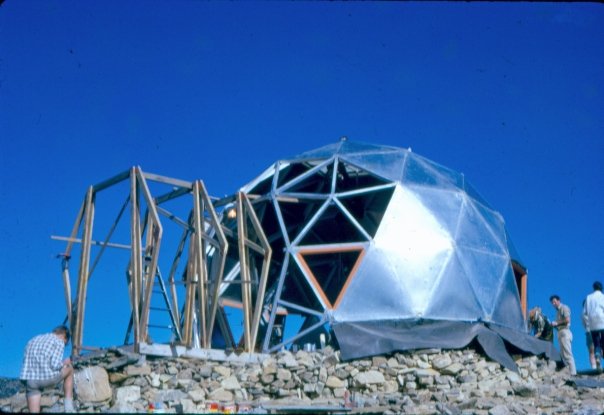
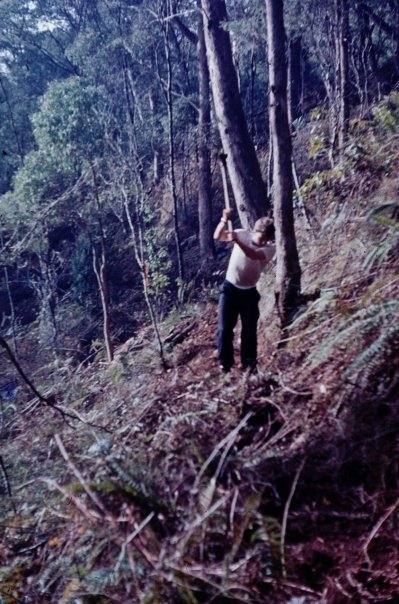
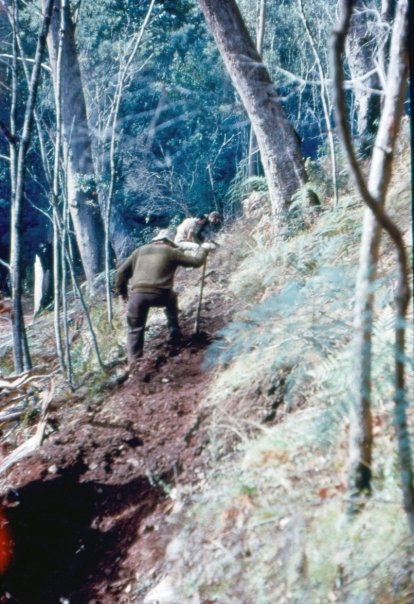
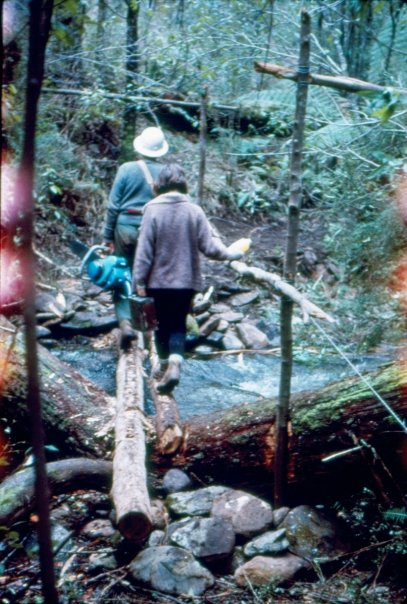
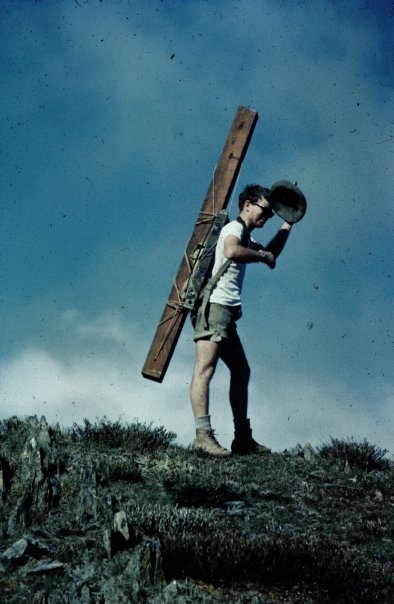
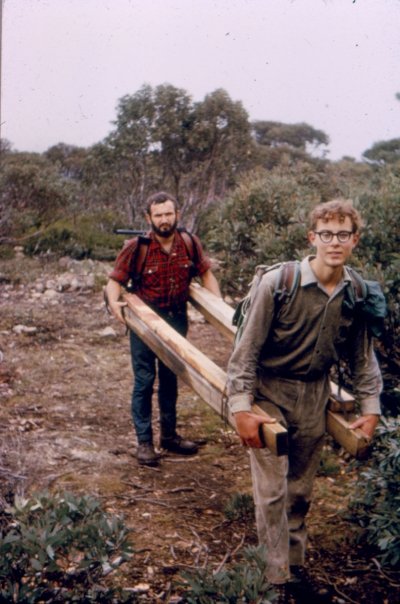
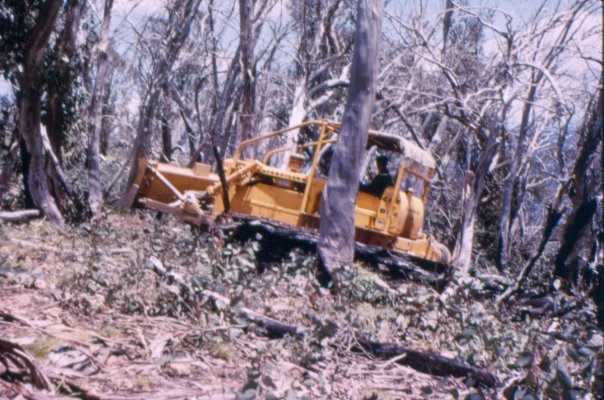
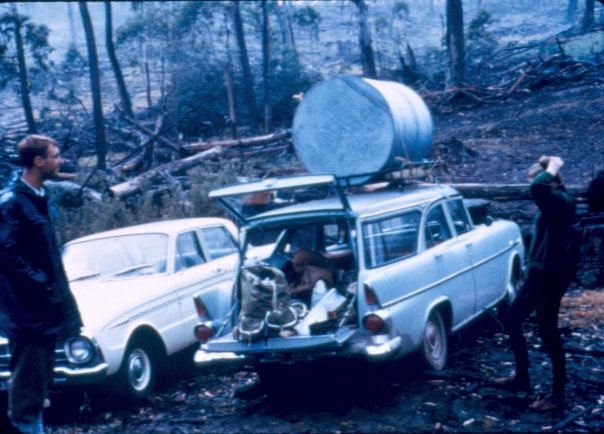
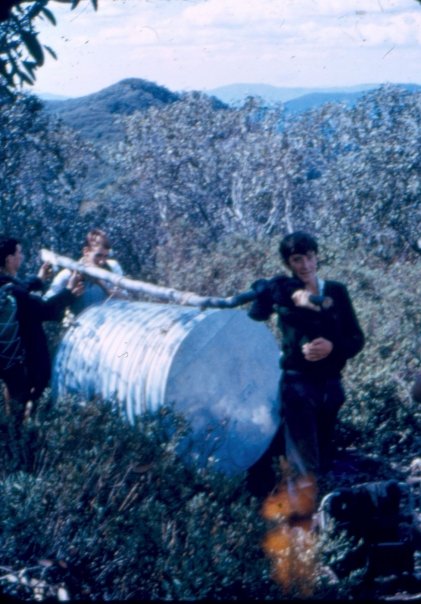
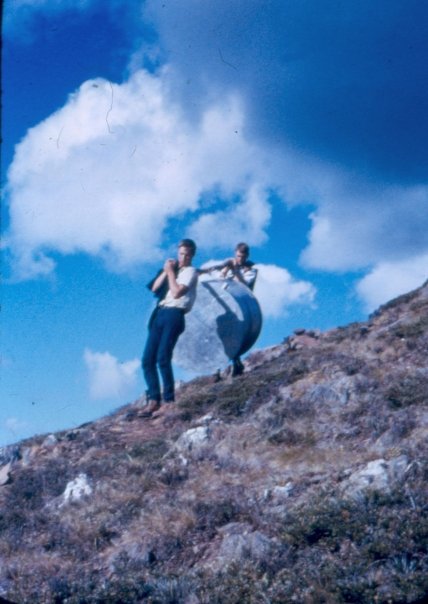

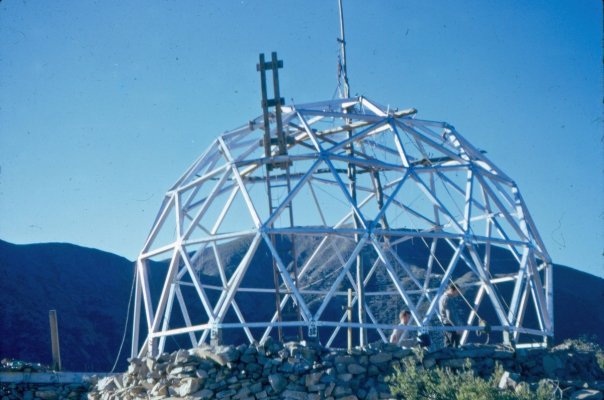
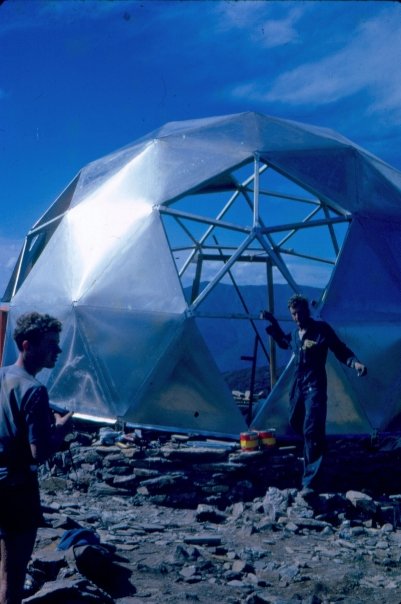
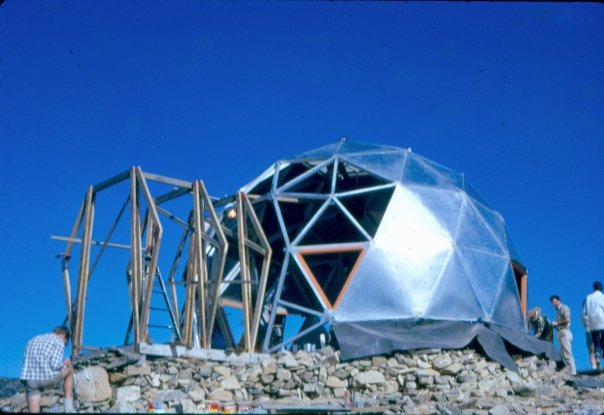
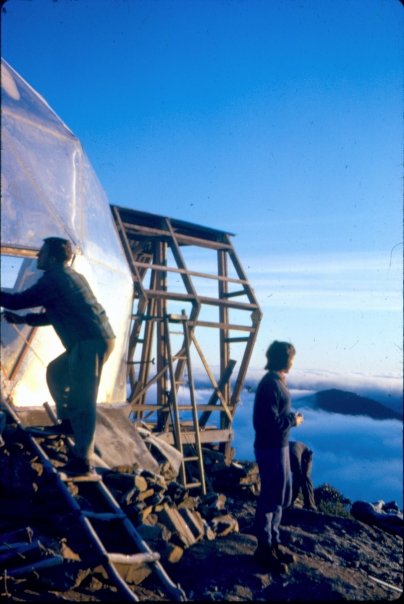
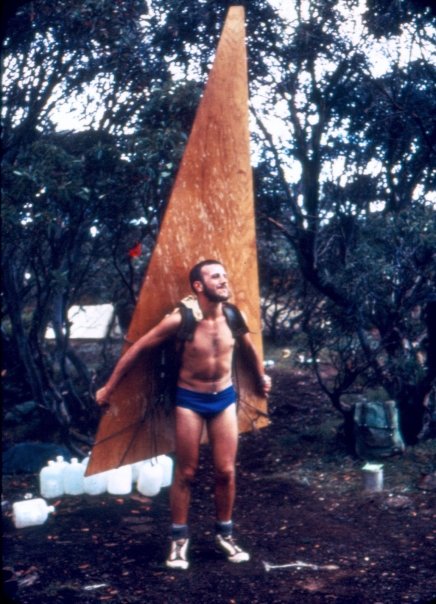
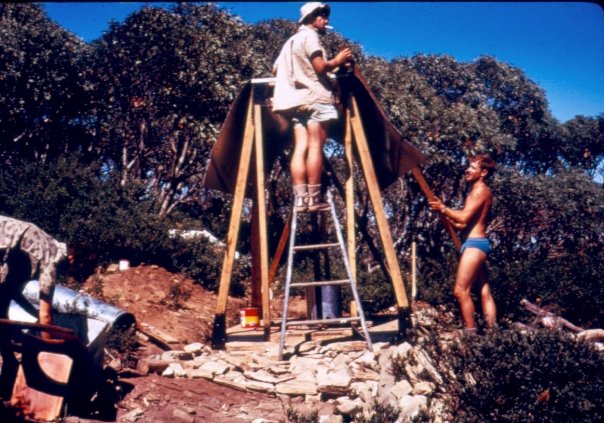
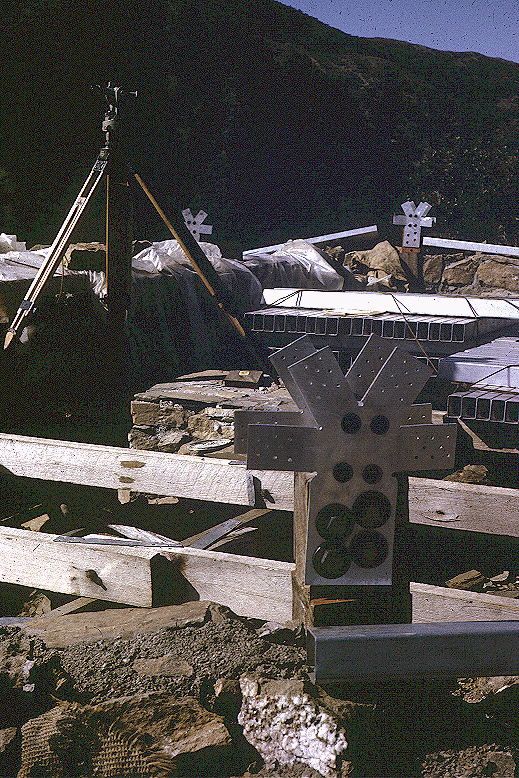
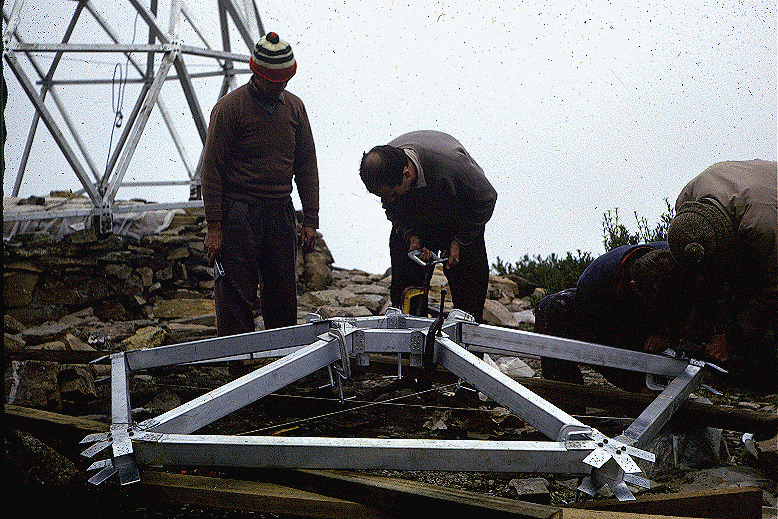
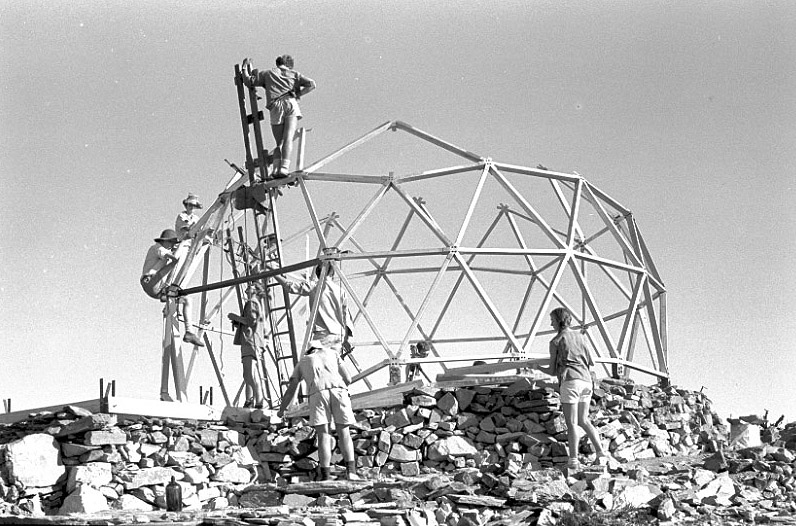
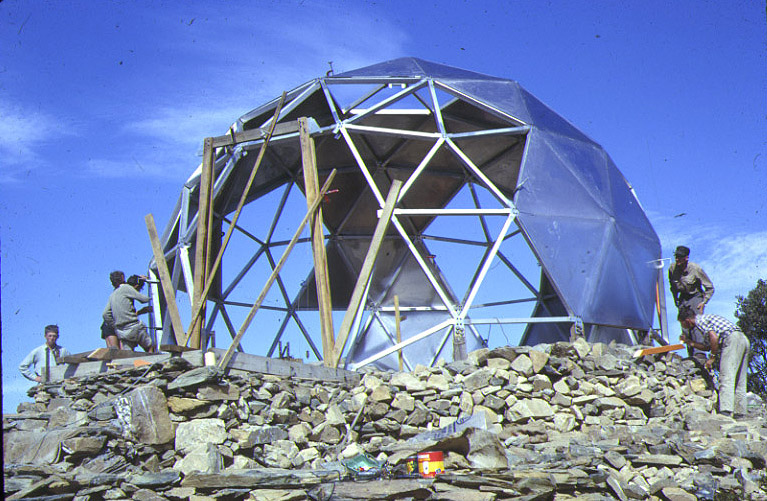

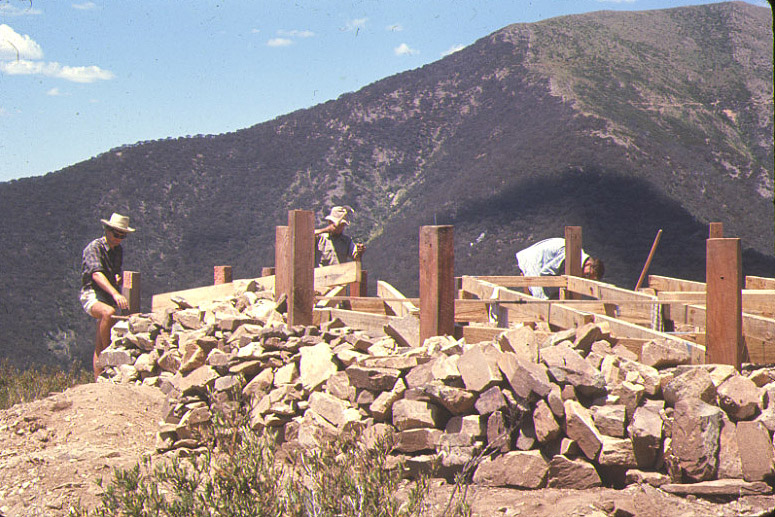
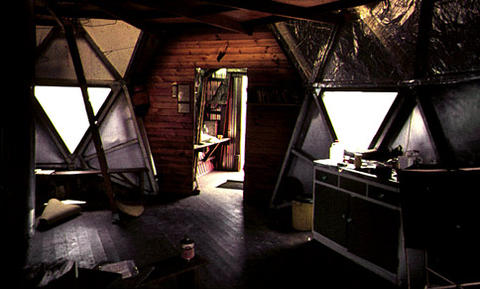
There were over 200 volunteers involved with the project. Those in Melbourne worked on fund raising, organising transport, sourcing supplies and prefabricating them as much as was practical. Those on Feathertop were kept busy with a variety of tasks. There were track builders constructing the new track that bypassed the summit, porters delivering supplies to the construction site from the recently extended roadhead on the North Razorback, labourers assembling the hut under close supervision. carriers bringing water from a nearby creek up to the construction site for making cement, and many other jobs. As was usual at the time, the men mostly did the construction work while women were in charge of catering. It's worth recording the names of the principal protagonists:
Hut Sub-Committee Convener Nick White Secretary, Jenny McMahon
Treasurer, Richard Schmidt. Design Officer, Peter Kneen
Catering & Fund Raising, Nina Rulevich Equipment, Tom Kneen Draftsmen, Tony Kerr and Cath Milvain Transport, Ron Jellef
Purchasing Officer, Lindsay Hackett. Packaging Officer, Bob Dewar
Reporter & Publicity, Margot Osborne
Track Clearing & Club President Phil Waring
Photo galleries of the construction of MUMC Hut provided by Peter Kneen






![This is a sketch of the original proposal for a hut. It was based on the approximate size of the hut on the Bungalow Spur. [Feathertop Hut built in 1912.] However the internal framing was very different which would have resisted the tendency](https://images.squarespace-cdn.com/content/v1/54b4bb3ee4b07950683ef3ba/1454098700683-RI15LJ4ITBRBJ4EN8XSS/7.png)



















































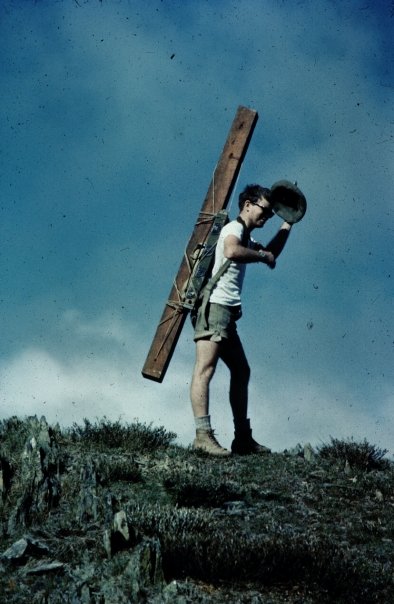




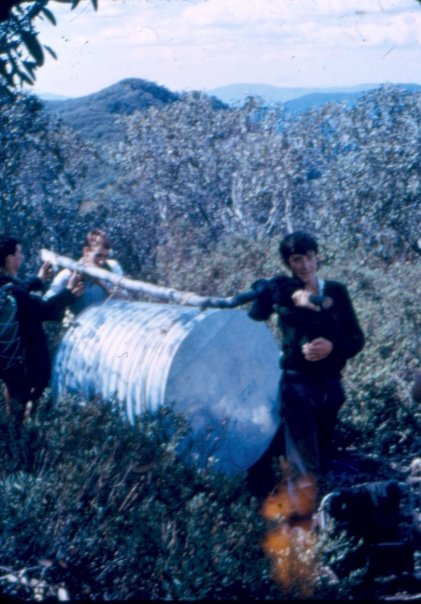
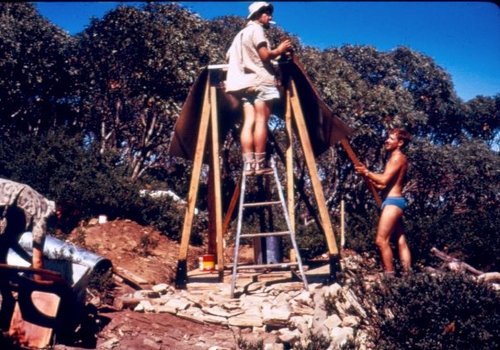

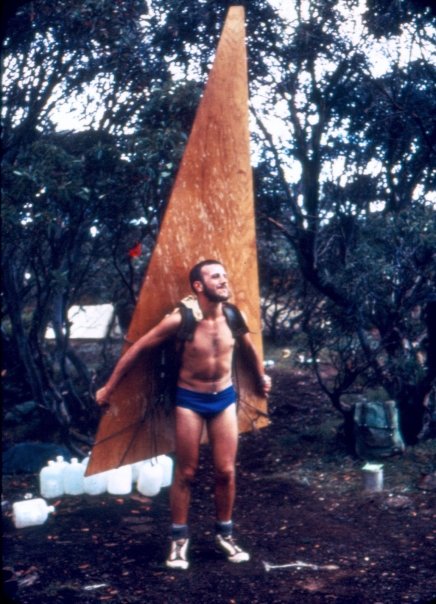
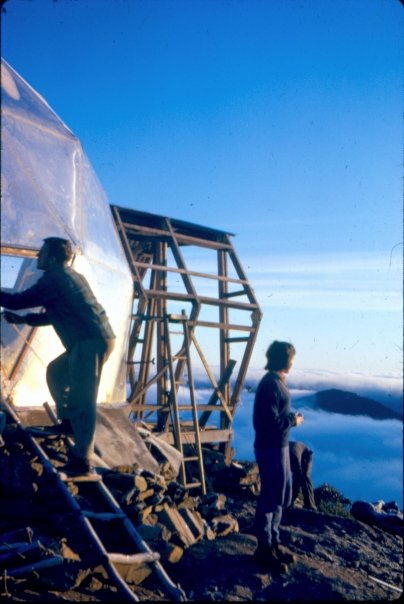
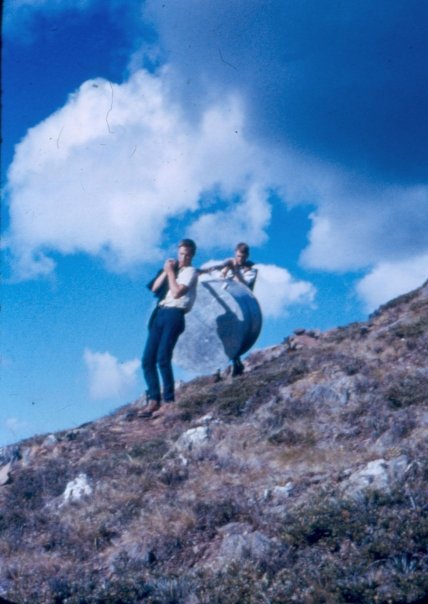
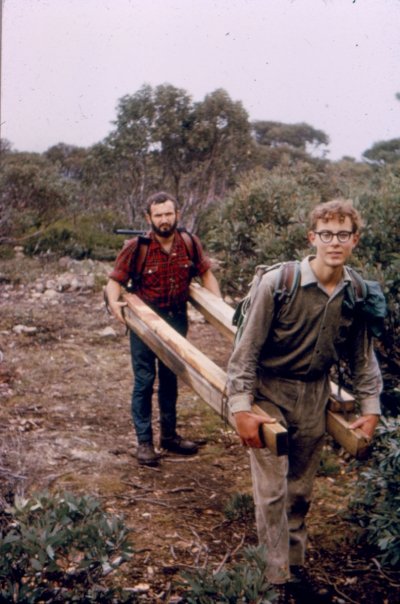
MUMC Hut interior showing the ladder leading to the upper floor. © David Sisson
Little MUMC Hut (the toilet). An equally radical statement as the main hut. Designed and built by Robert Vincent, burnt in the 2003 fires.
Hut description
The hut is circular, 6.4 metres in diameter at floor level, with a wooden floor in the spacious living area. The aluminium dome sits on a stone plinth which provides the lower section of the hut wall. A ladder leads to an attic sleeping platform suspended above the main room that can accommodate about 15 people. The hut has seven triangular windows letting light onto the living area with more windows facing towards the summit than in other directions. Furniture is fairly sparse, there are some seats against the walls and a large table with a pair of wooden benches.
The 2.3 x 3 metre entrance porch is clad in aluminium panels and has racks for storage of packs. It also provides a useful airlock between the interior and the weather outside. A locked grill in the floor of the entrance provides access to a storage cellar. Water is harvested from the roof of the entry porch and stored in tanks located in the cellar. There is a small sink against the living room wall and water is raised from the tanks using a hand pump.
There is little doubt that the hut was designed to make a statement. A 1996 heritage survey of mountain huts described it as 'reflecting the avant-garde architectural experimentation of the post-war era by the use of the geodesic dome and aluminium cladding'.
What is important is that the 'experimentation' also worked remarkably well in the hut's principal function as a mountain refuge. For over 50 years the hut has withstood often appalling weather while providing a large and comfortable living area and separate sleeping area. One of the minor details is that the door faces roughly north east so it catches the morning sun, but it also directly aligns with the summit of the Fainters, a reminder when exiting the hut that Feathertop is not the only high and steep mountain in the area.
One drawback for hut residents, (at least when compared to the cosy rebuilt Federation Hut nearby), is that it is a fairly cold hut, especially since the wood burning stove was removed. Insulation of polystyrene foam cut to fit inside the panels of the hut frame and covered by aluminium foil was originally installed, but it often became detached. Today most of it appears to have been removed.
Ventilation isn't usually a problem with traditional mountain huts built from wooden slabs, logs or corrugated iron, but the fairly well sealed hut has suffered problems with condensation leading to drips on people sleeping on the top level. Over the years leaks developed where the panels joined and these were attended to with varying speed according to the level of involvement from the changing committee of the student club.
So perversely, the hut sometimes leaks when it is raining and suffers from condensation drips when it isn't raining. Along with the peeling insulation, these were the major flaws of an otherwise well designed hut. But structurally the hut has been a great success and it has withstood everything that fifty years of wild mountain weather has thrown at it.
When the hut was built the silver aluminium covering was left unpainted, but complaints that it reflected the sun soon caused it to be painted a drab green, followed by a repaint in 1977.
The hut survived the 2003 wildfires, albeit with a temporary pink colour from the phos-chek fire retardant that a helicopter pilot thoughtfully dumped on it. However Little MUMC Hut (the toilet) was burnt. It was rebuilt in 2007.
While the hut is best known in club circles as the venue for an annual midnight ascent of the mountain, it is still used by the MUMC for its initial purpose of mountaineering training. Over the years other groups have used it as a base for training courses including the Australian Section of the New Zealand Alpine Club in the late 1970s. MUMC Hut remains a spacious and comfortable hut although it only receives a fraction of the visitors that nearby Federation Hut gets.
The old Federation Hut with its original cladding. © Tony Marsh. Used with permission.
Old Federation Hut. 1969 - 2003
In the summer of 1969 the Federation of Victorian Walking Clubs built Federation Hut at 1690 metres on the tree line at the top of Bungalow Spur. The location was already a popular campsite in both summer and winter as it was on ski runs that had been cleared of trees before the Second World War in the days of the Feathertop Bungalow guesthouse. The area provided the highest sheltered campsites on the most popular route up the mountain.
Plan of the original Federation Hut. From: Victorian alpine huts heritage survey, 1996. p 102
By the mid 1950s, it appeared that the old Feathertop Hut, just uphill from the site of the Bungalow, was approaching the end of its life and the Federation of Victorian Walking Clubs began to consider renovating it or building a replacement. In the 1950s this was just an idea tossed around by Federation committees and constituent clubs, but by the 1960s, serious proposals began to emerge. However being a federation, there were a multitude of views held by members of those committees and by the individual clubs, so things moved rather slowly and it appeared that the project would never progress beyond endless discussion.
This paralysis was broken by the example of MUMC Hut on the North West Spur of Feathertop, which was conceived, designed, authorised and built in just 11 months.
Two plans for a new hut on the old Feathertop Hut site were drawn up by Paul Kennedy, one was a similar design to the original hut while another was an A-frame. This was a popular style of snow architecture at the time and A-frame lodges still survive at three Victorian ski resorts as well as Diamantina Hut on the Great Alpine Road and the remote Vallejo Gantner Hut built on Mt Howitt in 1970.
It seems the main push to build a new hut was led by members of the Catholic Walking Club notably Paul Kennedy and Tom Buykx, while the Melbourne Walking Club and the Melbourne Bushwalkers opposed the project, although at the time both these clubs had their own private lodges elsewhere in the mountains. (The MWC owned the last surviving ski lodge at Donna Buang while the 'Bushies' owned Wilkinson Lodge on the Bogong High Plains.)
Building old Federation Hut. Photo Tom Buykx
The final design for a new hut proposed by Paul Kennedy was at a new site on the tree line, 1 km uphill from the old hut. It was closely adapted from one of Peter Kneen's proposals for MUMC Hut. It included three lessons learnt from Feathertop Hut. Firstly it had internal A-frame cross bracing to ensure it never developed the sort of lean that characterised Feathertop Hut in its later years. Secondly it included a large mezzanine sleeping area similar to that installed in Feathertop Hut to increase its capacity after the Bungalow was burnt down. Finally it had an entrance vestibule, which the old hut lacked. The vestibule was valuable for keeping the warmth in and the weather out in a gale or blizzard as it allowed the external door to be closed before the internal door was opened.
An unexpected difficulty was obtaining permission to build. The committee responsible for building the hut was bounced between Bright Shire, the Lands Department and, as the new site was just inside the ski resort boundaries, the Mt Hotham Committee of Management. The Harrietville Progress Association (owners of Feathertop Hut), the Tourist Development Authority and the Soil Conservation Authority also wanted their input to be heard. While none of these six organisations actively opposed a replacement hut being built, the long and tortuous negotiations were a foretaste of the maze of bureaucracy people have had to negotiate in more modern times.
Despite the fairly humble design, finding money to build the hut was also a problem. The estimated cost was $1020 and initially ten walking clubs committed $300 between them, Harrietville locals donated $100 and the Federation $100, leaving a considerable shortfall. Eventually $800 had been raised when it was discovered that the Tourist Development Authority would provide a 3 for 1 grant. After the grant was approved, a $3200 budget was now available. The extra money meant that the hut could be lengthened by 61 cm and that a helicopter could be hired to transport some of the building material.
So after dealing with the problems of the complex internal politics of the Federation, finalising a design, obtaining permission to build and finding funding, construction could finally begin.
Building material was trucked to Hotham Heights and then moved along the rough Mt Loch road to the top of Machinery Spur by the Land Rover Club. This was the closest place to the construction site on a 4WD road where a helicopter could land, thus providing a shorter flight path than if material was flown all the way from Hotham. However it has to be said that a lot of material for the hut was also carried in by the volunteer builders, either up Bungalow Spur or across The Razorback. After 15 years of procrastination, planning and delays, the hut was built in a couple of months after work started in February 1969.
The wood framed, aluminium clad hut had a stone and cement floor but was only 3.6 x 5.5 metres. A mezzanine loft over two thirds of the floorspace created a large sleeping area and the hut felt reasonably roomy, although it was a bit dark as the small window and a corrugated fibreglass panel in the roof didn't provide quite enough light. But building the hut was a great achievement, it provided an important refuge on a dangerous mountain and Feathertop had gone from having one semi derelict hut to having two new huts (and a semi derelict hut) in just three years.
Not long after Federation hut was built, a more radical view of human interaction with the high country came into vogue amongst some people. Proponents argued that there should be minimal trace of humanity in the mountains and that ski resorts, roads, huts, historic relics and even walking tracks should be removed. In the 1970s government authorities removed shelters in western Tasmania, the Central Highlands of that state and many huts in the Snowy Mountains of NSW, especially on the Main Range. While the Victorian government didn't go that far, some unnecessary 4WD roads in the high country were closed and ripped. In 1975 a few members of a major bushwalking club began a campaign to have Federation Hut demolished too.
Old Federation Hut after it was re-clad in wood by Ian Stapleton in 1988. Photo © Gary Duncan from his huts website. Used with permission.
The large toilet block at Federation Hut that survived the 2003 wildfire. © David Sisson
Fortunately nothing came from this lobbying, but the basic metal hut was regarded as a bit of an eyesore by many. Aesthetic objections were largely appeased when Federation Hut was renovated and reclad in pine boards by Ian Stapleton in 1988.
In 1986 what is now Parks Victoria took over ownership of the hut from the Federation. In 1996 the state government commissioned Butler heritage survey dismissed Federation Hut as being of no heritage significance, but acknowledged that the hut was a popular and potentially life saving refuge on the treeline of an often dangerous mountain.
At the turn of the century Parks Victoria installed a huge and elaborate double storey toilet block that dwarfed the old hut. Complete with verandas and twin staircases, it reputedly cost $200,000, an enormous amount at the time.
The 2003 fires were the worst in the high country since 1939. From the 24th to 26th of January CFA and DSE fire crews fought an epic battle to stop the fire at the Great Alpine Road, but conditions were so extreme and resources were so stretched that little thought was given to fire fighting on Mt Feathertop. However an attempt was made to drop fire retardant on Federation Hut, but apparently wind blew it onto the new toilet block.
After providing shelter for skiers and hikers for over a third of a century, the original Federation Hut was consumed along with about half of Feathertop's slopes and dozens of other mountain huts in the area. Assisted by the aerial spray of fire retardant, the 'mega dunny' survived.
New Federation Hut. 2004 -
The new Federation Hut not long after it was built. © David Sisson
This incomplete draft on new Fed Hut will (hopefully) be finished soon,
The new Michell Hut on Eskdale Spur, Mt Bogong was built to a similar design, but without the rangers room. © David Sisson 2005.
Transporting construction material to new Federation Hut.
DSE (now DELWP) summary of building new Fed Hut
In the winter of 2003, for the first time in 97 years there was no shelter near the top of Bungalow Spur. Parks Victoria had officially closed the mountain to the public after the fires. Of course the ban and the danger from falling trees didn't stop some people from visiting and by winter the areas around the sites of Feathertop and Federation huts had regained their status as popular camp sites.
During their existence Feathertop and Federation huts probably saved a number of lives, so it was always likely that a new hut would be built. A government report stated 'the hut at this popular site was considered essential for replacement because of its significant refuge value'. The newly established Victorian High Country Huts Association added its voice to those calling for reconstruction.
...
The old Federation Hut was almost perfectly located, and perhaps fortunately, it had been assessed as having no heritage value, so the new hut could be built on exactly the same site.
The burnt hut was replaced with a new hut built by Parks Victoria in December 2004. It was designed by the Wangaratta architect Tonique Bolt, prefabricated at Stanley and trucked to the Loch Car Park[?] at Hotham from where it was helicoptered to the site. Apparently the helicopter shuttled 11 loads of 400 kg.
The frame of the new hut is made from cypress pine, a native genus with durable wood resistant to decay and borers.
The new hut is a considerable improvement over the old one. It is well lit, very well insulated and the wooden floor means it is easy to sweep out. While there is no mezzanine sleeping platform, the benches along the walls of the hut provide a comfortable resting place for those who choose to disobey Parks Victoria directions about not sleeping in the hut.
An unusual feature of the hut is a small ranger's room which has a bed and space to store equipment.
A couple of sentences on design and construction. Info on the Wangaratta architect Tonique Bolt.
Information on who built or assembled the hut on site.
Was it entirely built by bureaucrats and/or their contractors, without assistance from interested people or groups?
The hut is built to almost the same design as the new Michell Hut on Eskdale Spur, Mt Bogong, although Michell Hut is smaller as it does not have the ranger's room.
...
The campsite near the top of Diamantina Spur where it is proposed to build the new huts. Photo © Taariq Hassan, 2017
Proposed High Knob huts
In 2016 a report was commissioned for an extended walking track between Falls Creek and Mt Hotham, with the final 106 page plan released in 2018. It is planned to increase the time for the walk between the ski resorts from one day to five days with a number of diversions from the direct route including an ascent of Mt Feathertop via Diamantina Spur. While most walkers would camp at designated campsites, it is planned to build small groups of huts, each accommodating three to four people for those unable to carry the extra weight of a tent.
One group of small huts is proposed to be east of High Knob near the top of Diamantina Spur (location shown on p. 75 of the report). However before environmentalists get upset or fans of huts get excited, bear in mind that the full plan is priced at $34.1 million, plus $1.2 million per hut with up to 10 huts at each site. If Parks Victoria is as cash strapped as we are led to believe, this new walking route will be built slowly in piecemeal fashion. Building new huts in an area without road access is likely to be one of the last things to happen, so they may be put in the too hard basket (or too expensive basket) indefinitely.
--oo0oo--
Essentially since the Second World War, Mt Feathertop has been much the same as now. Skiing is for serious backcountry types only, although, in summer, the summit can be visited in a long day trip via The Razorback or Bungalow Spur. While Feathertop was a moderately popular destination for skiers before the Second World War, it was never a major rival to Hotham. © David Sisson, 2016.
The Herald. Tuesday 16 May 1933, page 3.
7. The death of Molly Hill and other fatalities
The plaque spells her name Mollie Hill but the gravestone in the Cheltenham Pioneer Cemetery has it as Molly Hill. © Chris McLaughlin of nevictoria.com. Used with permission
South of the summit ridge, at the start of the Razorback, there is an 1,803 metre high hill with a small cairn and a plaque in memory of Molly Hill*, a 30 year old nurse from Glen Iris who was the first skier known to have died in Victoria.
Mary (Molly) Ann Hill was an experienced skier and walker. The Melbourne Women's Walking Club history mentions her undertaking an extended hike on the Bogong High Plains in 1928 and another source has her climbing Mt Fainter in 1931, possibly making her the first woman to climb Victoria's fourth highest peak in winter.
Hill was with a group from the Ski Club of Victoria organised by Jack Docherty that was stuck at the Feathertop Bungalow during six days of poor weather. On Friday 2 September 1932 conditions finally improved and a group of three women and three men set out from the guesthouse for Hotham Heights Chalet. This was just before the time when metal ski edges were common, making traversing icy slopes on wooden skis especially hazardous.
Molly Hill cairn with the summit behind. © Wayne Cherry 2007. Used with permission.
One source says that before her fatal accident, Hill slipped and injured her wrist, but after her arm was put in a sling, opted to continue with the crossing. After the group climbed to the Razorback, about 2½ km from the Bungalow, Molly slipped on a steep patch of ice and unable to use her ski poles to self arrest, slid either 60 or 100 metres (sources differ) down a steep slope before hitting a tree which splintered on impact.
Docherty immediately descended to Hill and found her unconscious body hanging from the straps of her pack with her head bleeding heavily. She was placed in a sleeping bag and put on a stretcher, probably improvised from skis and poles, and moved to the Bungalow where a group of nine men from Harrietville including Mounted Constable Harold Dudley and Dr George Waterhouse arrived at 1.00 pm. She was stretchered down the mountain to Harrietville and then driven to Bright Hospital. Despite an emergency operation, Molly Hill died of intracranial bleeding from a depressed fracture of the skull at 10.00 that night.
She is buried in the Cheltenham Pioneer Cemetery, only 100 metres from another skier, Cleve Cole who died after being confined to a rough snow cave for several days during a blizzard on Mt Bogong during in 1936. While the knoll that the memorial cairn stands on has never been formally named, it is universally known as Molly Hill. Newspaper reports of Hill's death can be found in chapter 12 of this article.
In 1933 the SCV announced a proposal to build to build a memorial cairn on a hill near the site of Molly Hills accident, but I have been unable to confirm if the cairn was built then or some years later. By early this century the cairn was showing increasing signs of deterioration and it finally collapsed at some time before September 2016. In April 2018 the memorial cairn was rebuilt by Frank Vickers, a local stonemason.
* Hill's name is spelt Molly on her gravestone at Cheltenham Pioneer Cemetery, but Mollie on the memorial plaque on the Razorback cairn. If the plaque was cast after the Second World War the alternate spelling may be due to confusion with a different Mollie Hill who was an artist and prominent member of Myrtleford and Wangaratta ski clubs in the 1950s.
Apart from Molly Hill, many other people have died on Feathertop including:
Desley Mason, a student at Gordon Institute of Technology in Geelong who drowned crossing flooded Stony Creek at the base of North West Spur in July 1974.
Steven Galland, a 19 year old member of the Melbourne University Mountaineering Club slipped and fell while building a snow cave near the summit on 21 August 1983. Poor weather prevented a helicopter rescue and he died a few hours later.
Tom Kneen was an environmental activist known for his opposition to development in the mountains including ski resorts, huts and walking tracks. He died on the summit ridge in August 1985 when he strayed too close to the edge of the cornice, which collapsed under him. Tom was a cousin of Peter Kneen, the designer of MUMC Hut.
Keith Telleson of Geelong died on 9 August 1986 when he fell on hard ice towards the southern end of the Razorback and slipped down the eastern side for 100 metres before hitting a tree. Dr Telleson had been rescued two years earlier when he became lost in the headwaters of Stony Creek on the west face of Mt Feathertop.
The media reported that the body of a man in his fifties who 'did not want to be found' was discovered in the precipitous Hellfire Gully on 23 July 2006. I was visiting MUMC Hut, the summit and Federation Hut that weekend and while descending, I met police search and rescue going up the mountain. They confirmed that the reports we heard on the radio were correct.
Graeme Nelson was a doctor from Eden, NSW, who was known as an expert amongst backcountry downhill skiers. I knew him slightly and admired him greatly. He died on 24 August 2011 after catching a ski edge below the summit and sliding 700 metres down Avalanche Gully until stopped by debris from an earlier avalanche.
This list is not comprehensive and there are a few memorial plaques for other people discreetly placed on the mountain, although none confirm that the person died on Feathertop. It is possible that a snowboarder died on the mountain in the first decade of this century, but without more information, I won't add another name to this list.
8. Hiking routes on Mt Feathertop
Walking routes on Mt Feathertop. The Great Alpine Road is shown in red.
Mt Feathertop is one of the most appealing peaks in the high country of Victoria. It provides terrific hiking in summer and in winter it is a great venue for snow-shoeing, mountaineering and extreme skiing and boarding. But be careful, it averages almost a death per decade. All deaths (so far) have been in winter and many have been due to not treating the summit ridge cornice with the full respect it deserves.
Maps. A decent map is essential when visiting Feathertop. The most useful and accurate map is Mt Feathertop - Hotham 1:30,000. 2nd edition. Rooftop, 2009. The 1:50,000 scale maps of the Bogong High Plains area published by Spatial Vision and Rooftop are also pretty good, although the Spatial Vision maps are not fully field checked, so features like roads and tracks are not always accurately shown.
Walking routes up Mt Feathertop (Anti clockwise from the north.) Most of the mountain was toasted in the 2003 and 2006 fires and the regrowth in some areas is still quite thick, making walking off track difficult below the treeline. All tracks from before the fires have been restored except the Trout Farm - Stony Tops track (not shown). Parts of Champion Spur have been cleared, although there is still a lot of scrub on that route. © David Sisson
NORTH RAZORBACK or Stony Tops
Shown in Brown on the map. Relatively easy, but exposed. 4.1 km from the summer 4WD road head to the summit. 7.3 km from the winter gate at the end of the rough 2WD section of the road.
To get to the North Razorback, turn off the Great Alpine Road (B 500) just south of Bright at Germantown on the Mt Beauty Road (C 536). Cross the Ovens River and immediately turn south along Snowy Creek Track (aka Dungey's Track). If you're in a low clearance 2WD, park at the end of the freehold land and walk for about 4 hours. If you're in a 'soft roader' AWD or a proper 4WD, continue southwards, heading right at every main road junction (ignoring short logging tracks). Eventually you will climb up to Stony Creek Tops.
At Dungey Gap (1300 metres) you will find the seasonal road closure gate (locked between Queen's Birthday and Cup Weekend), and a large clearing that has recently been cleared of a blackberry infestation (thanks Steve). 200 metres north east of the road is a large metal fire water tank full of rather dodgy water., but just below it is a small creek with good water which flows most of the year. (Don't rely on it from January to April.)
The road deteriorates from here, so walk the last 3.2 km unless you have a real 4WD. At the end of the road, it is only 4.1 km to the summit along the North Razorback walking track which continues over undulating ground for another 3 km. At the treeline the track fades to a footpad and is easily lost. But the steep 1 km route to the North Peak is obvious. At the North Peak find the track again and walk along the summit ridge to Mt Feathertop.
Map notes. If you have an older map, ignore the walking track that may be shown between the North Razorback and MUMC Hut. Originally a route for droving cattle, it was rebuilt to transport material when MUMC Hut was being built, but it has now been overgrown for 50 years. The ground the former track traversed is very steep and scrubby, so even if you are heading for MUMC Hut, it's much faster and easier to take the indirect route over the summit. The first edition of the Rooftop map also shows a walking track from the trout farm at the base of North West Spur to Stony Tops. This was in reasonable condition before the 2006 fires, but it has not been restored and is no longer maintained.
NORTH WEST SPUR
Shown in Orange on the map. A steep, hardish slog. Turn off the Great Alpine Road (B 500) onto Stony Creek Road 20 km south of Bright or 5 km north of the Harrietville general store. The road crosses the river and splits into a number of tracks, but follow the main track east for a few hundred metres and park your car.
Follow the dirt road along the south side of Stony Creek. Don't cross the creek before the walking track starts and you are well away from farm land. After an initial climb, the walking track descends to a creek with reliable clean water 2 km from the start of the track and then the serious climb begins. It is long and steep. Higher up there are a couple of spots where the track isn't always obvious, so pay attention to the route once you are amongst snowgums. MUMC Hut is 7.6 km and at least 3 hours walk from the car park. It provides a welcome break and is large, clean, and roomy. However as there is no stove, the hut is pretty cold, especially in winter.
From the hut follow the relatively gently graded track along the ridge to the West Face of the mountain. The short section of track that crosses the steep West Face passes a reliable spring and leads to a track junction between the summit and Federation Hut. Either head up to the summit or south to the start of the Razorback.
While snow doesn't build up on the West Face all that often, it is very steep and if you are following this route after a decent snowfall, be aware of potential avalanche danger a few hundred metres either side of the spring. The evidence of smashed and uprooted snowgums on the treeline below the spring is evidence that avalanches do occur on this section.
BUNGALOW SPUR
Shown in Yellow on the map. The most popular route for overnight walkers. 8.2 km and 3+ hours to Federation Hut, plus another 1.8 km to the summit. The track was built for pack horses and tractors that serviced the Feathertop Bungalow, a hotel that used to operate near the top of the spur, so it's relatively easy going. Federation Hut at the top of Bungalow Spur is large, clean, roomy and well insulated. In winter the wood fueled stove will keep the hut warm all night, as long as both doors are kept shut. If you use the stove, make sure you replace the wood you burn.
Access. Drive to Harrietville on the Great Alpine Road (B 500). Just north of the bridge over the East Branch of the Ovens River, turn onto Feathertop Track and follow the road south east for 1 km. Park your car at the information board, just before the road turns north and crosses a creek.
It's easiest to think of the walk to Federation Hut as four sections of 2 km, each of which takes under an hour. The first two sections to Picture Point and Tobias Gap feature a winding climb on the side of the mountain, initially through tall forest and tree ferns, alternating with dryer areas of peppermint forest in areas that get more sun. In winter, light snow is usually found at 1,100 metres near the halfway point at Tobias Gap.
New Federation Hut and its huge toilet on the at the top of Bungalow Spur. © David Sisson
The third section is much straighter as the track stops zig-zagging and heads directly up the spur towards the hut. The end of this section is at a corner where a muddy stream crosses the track. From here. it is 1 km to the site of the Feathertop Bungalow, followed shortly afterwards by the site of Feathertop Hut. This flat open area is a good place to take a breather before the final kilometre along the snowgum lined ridge to Federation Hut. In winter this section is often covered in deep snow, but the route is usually obvious as it is fairly straight and regularly packed down by walkers and skiers.
The tank at Federation Hut is labeled unsafe to drink, however this is just Parks Victoria covering themselves against ambulance chasing lawyers, I've never heard of anyone becoming even slightly ill from drinking its water. Be aware that the tank has been known to run dry in summer, which may mean a 30 minute return trip down to the reliable spring near Feathertop Hut site.
From Federation Hut the track heads north east, joining the Razorback track after 400 metres. After another 400 metres, the track across the West Face of the mountain to MUMC Hut diverges and the steep 1 km walk to the summit begins. In summer stick to the built track to help reduce erosion. In winter snow, stay back at least 5 metres from the top of the ridge to be safe from cornice collapse.
Note: Technically, the Bungalow Spur track only follows Bungalow Spur from above Wombat Gap. Off track notes for purists who wish to follow the full length of the spur from Stony Creek can be found in three older editions of Tyrone Thomas' 120 walks in Victoria: the 5th edition, 1989 (pp 392-393), 4th ed, 1984 (pp 264 - 266.), 3rd ed, 1977 (pp 194-196).
CHAMPION SPUR
Shown in Green on the map. A moderately difficult and rarely used route recommended for those who are not afraid of a little scrub bashing and who are looking for a new route up Mt Feathertop. The route follows the old river level East Ovens Track from Harrietville before turning east up a former forestry road to run straight up the middle of Champion Spur. This section of the track along the river is now partly eroded and overgrown, so it may be better to follow the Bon Accord track for 3 km and scrub bash down to the river before fording it and picking up the old track from there.
Once away from the river, the old track generally sticks to the middle of the spur. While it was not burnt in 2006/07 fires, a dozer was sent up it at that time to provide clear access. Beyond the road head near the top of the spur, a 80 cm wide track was cut for the last 1,200 metres to join the Razorback walking track a little to the south of the corner at grid 112 137.
If you are heading down Champion Spur, look for a gap in the trees on the ridge top to the west of the Razorback walking track just south of the corner. The short walking track linking the Champion Spur forestry road with the Razorback has not been maintained and is slowly becoming overgrown again.
BON ACCORD SPUR
Shown in Blue on the map. 13 km from Harrietville to Diamantina Hut on the Great Alpine Road. A slog, steep in parts, but not too bad. From Harrietville head south down the Bon Accord Track. The route follows an old mining road originally known as the Black Hole Track for 4½ km along the East Branch of the Ovens River that has been in continuous use for over 160 years. Until the turn of the 20th century there was a small community of fossickers living in this area and the ruins of their huts and water races can still be seen if you keep an eye open for them. Several bridges have been built over the river, so if the latest one is still in place, crossing will not be a problem. There is a camp site beside the river, it has the last water before the end of the spur at the Razorback, so make sure you fill your water bottles here.
The uphill part of the walk begins immediately after the river crossing. Alternating between steeper and more gentle gradients, the track climbs to the site of Bon Accord Hut. The hut was a staging post for pedestrians and the pack horses that used to service Mt Hotham ski resort in winter in the 1940s before the road was cleared of snow. It was burnt in 2003 fires and Parks Victoria vowed that it would not be rebuilt. With the loss of the hut, there is no water on this route past the river, so camping at the hut site means you must carry all the water you will need for the night.
From the hut site, the track bypasses the orignal zig zags in the track and climbs very steeply straight up for 1 km to the tree line before the gradient eases a little. This was the point where pack horses were usually unloaded and luggage was transformed to sleds drawn by horses wearing snowshoes. The track continues to climb until It joins the Razorback at the top of Big Dipper Hill, 1 km north of Diamantina Hut on the Great Alpine Road.
THE RAZORBACK (SOUTH)
Shown in Purple on the map. 11 km, 4 hours each way. Long and dry (take at least 2 litres of water each for a return trip, more on warm days), but relatively easy going. In summer this track is popular with walkers who often over estimate their speed, so allow plenty of time if you plan to do the return walk in a day and make sure you are on the track by 10.00 am at the latest. The route is generally pretty exposed and you shouldn't undertake it unless the forecast is for fine weather. Even so, the weather in the area is especially volatile and you should always carry a decent raincoat, no matter what the forecast is.
In summer it is the easiest way to get to the top of the mountain, but in winter it is covered in deep snow and is pretty heavy going. For snow shoers, Bungalow Spur is a much easier route.
The walk along the Razorback starts at Diamantina Hut on the Great Alpine Road, 3 km west of Hotham ski resort. 600 metres out, the track splits, the western branch goes over Big Dipper Hill, the slightly less obvious eastern branch takes an easier route, contouring around the hill to the east. Both tracks rejoin at Big Dipper Saddle.
The scenic track undulates northwards, sometimes above the tree line, sometimes just below it. As you get closer to the mountain the views slowly improve. Head past High Knob and you will soon see a hut to the west (your right). Stay on the main track and ignore the track descending to Federation Hut and Bungalow Spur. After 400 metres another junction is reached. The track to the left heads to MUMC Hut and North West Spur, but you should take the right hand track which heads straight up the summit pyramid. After a long climb the track flattens out at a false summit, but the true summit is a couple of hundred metres further on.
DIAMANTINA SPUR
Shown in Pink on the map. The track starts at the West Kiewa River Road (accessed from Mt Beauty, but closed in winter). It climbs 4 km to join the Razorback track 3 km south of the summit. The route is shortish, but scrubby, steep and sharp with loose shale. The track does not appear to be maintained, parts were burnt in the 2006/07 fires.
EAST RIDGE AND NORTH EAST SPUR
Shown in Olive on the map. The East Ridge descends from the North Peak of Feathertop, the route down North East Spur diverges from the Razorback 300 metres further north. No tracks on either route, but when the area was burnt in the summer of 2006/07, it opened a brief window when mere mortals could walk them. Both are ridiculously steep and sliding down is preferable to climbing up them. As the scrub has grown back, they have returning to their former status of being strictly for heroes only. Extremely steep and scrubby with dense blackberries near the West Kiewa River.
The summit ridge of Mt Feathertop showing the cornice, Avalanche Gully and Hellfire Gully. Photo from an excellent review of backcountry steep skiing in Victoria by 'Huck and Dyno'
WINTER ACCESS
In winter, most people climb Feathertop via Bungalow Spur. The track is sheltered from the weather and is easily followed as far as Federation Hut. North West Spur is also used, however it is a harder walk and more difficult to stick to the track through the snowgums when it gets close to MUMC Hut. The route from the Great Alpine Road along the (southern) Razorback is a much more difficult proposition than in summer. It is covered in soft deep snow that is difficult to move over and usually features an occasional cornice to keep skiers or snow shoers minds on the task.
The Razorback and Mt Feathertop under heavy snow. © Taariq Hassan, 2018
In winter, the road leading to the North Razorback is only open to the seasonal closure gate at Stony Tops, however it can be quite muddy, so it would be wise to take a proper 4WD with good clearance, low range gears, tyre chains and a chainsaw. You may be able to drive right to the gate, but as this is at over 1,300 metes, a heavy snowfall could mean you will be unable to drive out and instead have to walk for 5 hours down the road to civilisation at Freeburgh, returning to retrieve your vehicle after the spring thaw.
While most experienced hikers can follow these routes in summer, winter is a very different proposition, especially the final climb to the summit. Specialised knowledge and equipment is necessary. Generally on steep slopes above the tree line, you should be wearing crampons (boot spikes), carry an ice axe and know how to use the axe to 'self arrest'. In some conditions heavily cramponed snowshoes with a fold up heel and whippets (ski poles with small axes projecting from the handles) may be adequate, but until you know the mountain in winter, it's wiser to err on the side of caution and take proper crampons and a full sized axe.
Remember that quite a few people have died on Feathertop, in 2011 the loss of one of our most experienced and careful backcountry skiers showed that it's not just novices who run into trouble. So be cautious and go with a person who has at least basic mountaineering experience. You can't learn this sort of thing from books or through trial and error.
What not to do. A 1929 photo of the summit ridge by Warrand Begg showing skiers standing on a cornice that could easily collapse. This is one reason why Feathertop has the highest body count of any mainland Australian mountain. (Although Federation Peak in Tasmania has had slightly more deaths.)
You should also be aware of the signs of avalanche danger (usually light, unconsolidated snow over hard packed snow or ice) and be prepared to turn back if there is the possibility of an avi or if the weather looks dodgy. A good summary of avalanche conditions and safety in Australia can be found at this link. While avalanches are most common on the east side of the summit ridge, they can occur anywhere on the mountain as the smashed and uprooted snowgums at the base of the west face (Harrietville side) attest.
Above all, you should be constantly aware of the cornice on the east (Bogong High Plains) side of the summit ridge. Always stay at least five metres back from the apparent top of the ridge. A cornice is formed when wind blows snow over a ridge. At the top of the ridge, the wind lessens on the leeward side and the snow drops to form a structure a bit like a breaking surf wave. A person can stand on top of a cornice and be unaware that there is thin air a few metres beneath them. Cornices are often fragile and the weight of a person or even movement nearby may cause them to break without warning. Feathertop's summit ridge cornice has the highest body count in Australia so be careful not to add to the death toll.
APPENDICES
Historic documents on Mt Feathertop.
Feathertop 1930 from Lake Spur just above where Westons Hut was built Photo Kath Magill
9. FEATHERTOP BUILDINGS IN 1936
From: C. J. M. Cole. Victorian chalets and shelters, in: Australian and New Zealand ski yearbook 1936. Page 22.
The Bungalow, Mt Feathertop. Controlled by the Victorian Railways Commissioners. Location on Mt Feathertop about 1½ miles from Summit. Distance from Harrietville by pack track, 5½ miles, from Hotham Heights by Razorback Ridge, 9 miles. Altitude 5,000 feet. A well-built and comfortable iron chalet which accommodates 24 people. Hot water and telephone installed. Reservations. Government Tourist Bureau. Ease of approach in all weathers renders the Feathertop Chalet a popular resort during the months of June to September, when a regular staff is on duty. Special arrangements may be made at other periods. Fine practice and racing grounds are available. Serious tours along the Razorback to Hotham and to Bogong High Plains by Blair’s Hut are recommended only to skiers with experience.
Feathertop Hut. Owners, Harrietville Progress Association. Location Mt. Feathertop. 1½ miles from Summit, 70 yards north of Bungalow. Altitude 5,000 feet. Size 19 x 11 feet. Construction, galvanised iron, lined with pine, wooden floor and one window. Equipment includes bunks for 6 people, table, shelves, axe and billies. Water is conveniently available.
Razorback Hut. Controlled by the Tourist Committee. Location : On Razorback Ridge. Distance from Feathertop Bungalow 4 miles, Diamantina Hut 3½ miles. Altitude 5,350 feet. Size, 14 x 10 feet. Construction, a galvanized iron hut with window but no floor. Equipment is limited to a table. Water is not readily accessible. Locate spring down gully on west side of ridge.
Lawler's Hut. Located at the head of Snowy Creek, 16 miles from Bright, 6 miles from Brigg's Hut and 7 miles from Feathertop Bungalow. Altitude 4,500 ft. Constructed of logs with bark roof - shelf bunk accommodates 6 people. ... This hut was on the North Razorback near where the fire water tank and the seasonal closure gate on the Stony Tops Track are today. It was the nearest cattlemen's hut to Feathertop. There were two other Lawler's Huts at the time, one was next to Hotham Heights Chalet and the other was on the West Kiewa River, 6 miles (10 km) downstream of Blair's Hut.
The inconsistent punctuation and spelling (galvanised - galvanized, etc.) is original.
Members of the Wangaratta Ski Club at the Bungalow in 1930. Photo Kath Magill.
10. Feathertop Bungalow documents
The Chalet at Mt. Feathertop. Gordon Langridge
Gordon Langridge was the founding president of both the Ski Club of Victoria and the Chamois Ski Club. He was main force behind the construction of the Feathertop Bungalow in 1925. In 1948 he wrote about his experiences with the project.
This, of course, is all ancient history now. But some of you will have forgotten it, and so here it is -- how Feathertop got it's bungalow in 1925, to be destroyed alas, in the bushfires of 1939. There is still good ski-ing there, and maybe another will be built some day, for it is one of the easiest mountains to get at from Harrietville.
The Mount Buffalo Chalet, built in 1910 by the Victorian Public Works Department, was run for many years by Miss Hilda Samsing as lessee. She handed it over to the control of the Victorian Railways in August, 1924, and shortly afterwards I asked her if she would be interested in opening another snow resort. The answer was "yes".
As a result, a meeting was arranged of those interested and it was decided on Mount Feathertop (6267 ft.) as the objective. After going into the question of title, it was decided to take out a number of Miner's Rights for various positions. The spot selected was governed by the problem of water supply, and after several examinations, one just below Little Feathertop was chosen. A Right was also taken out for the supply of water.
These details took some considerable time to complete. we then consulted a well-known road contractor in the Bright district -- I forget his name -- about the construction of a road from Harrietville to the site that could be kept reasonably clear of snow in the winter. It was suggested by him that the existing five miles of "track" could be made into a one-way road at very little cost. Otherwise it would cost, for a re-survey of the "track" and a new road, about £30,000. We then proceeded to enquiries as to the proposed building, a well-known Melbourne architect, Mr. E. F. Billson, prepared tentative plans for a project to cost something in the vicinity of £80,000.
In the meantime it was proposed to build a smaller building to accommodate about thirty people. Considerable time was taken up in getting data, as no building for snow purposes had previously been erected in Victoria. We wrote to a firm in Norway who supplied a lot of information, including a full working plan of the famous Holmenkollen Jump, costing £10,000, which they had built.
Timber at that time being very easy to get, we had the structure for the whole building cut up and laid out in sections, each side being painted a different colour. This work was done in Prahran, Melbourne, by Davies and Co., on a vacant allotment adjoining their premises on Malvern Road. These sections were forwarded to Bright, thence to Harrietville, from where they were sledged five miles up the mountain by six teams each of six horses. Though considered a very hard task, this was duly accomplished by the contractor a day before snow fell and held up all work, burying everything for a week.
The building consisted of eight bedrooms, each of four bunks, fitted with wire mattresses, a large dining room and lounge combined, two bathrooms, kitchen with stove in the centre, hot water system and electric light throughout.
The erection of this structure on the spot took only three weeks for a team of seven carpenters, two plumbers, and six labourers. The Bungalow, as it was called, was comfortably fitted up inside and stocked with fifty pairs of Norwegian skis.
The formal opening took place with due ceremony on July 13, 1925, and quite a number of prominent people were present including Doctor and Mrs. Barry Thompson, Mr. and Mrs. Mitchell of Lilydale, Miss J. Gerrard, Mr. A. E. Callaway of C.R.B., Mr E. Williams of Tourist Bureau, Mr. H.R. Gollan of the Railways, Mr J. E. Toole of the Millions Club, Sydney, Mr. and Mrs. Fred Rattan (secretary to the company) and various members of the ski-ing community. During the evening a number of rockets were fired, and these were seen in the surrounding districts.
During the building and formation of the company, I am very sorry to say, we found some Government departments very much against our project, and they put every obstacle in our way. During the negotiations with the Government Solicitor over our site, it was suggested that a fifty-year lease should be granted. This came along after some delay and was progressing very well, when it was suggested that it should be submitted to the Railways Commissioners in case it might be thought prejudicial to their interests at Buffalo. The Railways held the proposed lease for some considerable time and then suggested quite a number of alterations, one of which was that they should have the option of purchase at the end of the first seven years.
A stalemate resulted on the question of the lease because of their proposed conditions, and the promoters abandoned the project after eighteen months of fruitless negotiation. The company went into voluntary liquidation after selling an asset to the Victorian Railways for £250 which had cost us £3000.
The Bungalow had run profitably for it's first two years under the company's management --although intended more as preliminary publicity for the major project which was planned to follow, than as a profit-maker itself -- and it will now remain a matter only for idle speculation whether the £80,000 project would have changed the whole history of ski-ing in Victoria. At all events the attitude of the various Government departments seems to have changed radically for the better since then!
Australian Ski Yearbook 1948. Pages 105 - 106.
Feathertop summit August 1934. Photo K Magill.
The opening of Feathertop Bungalow
MOUNT FEATHERTOP. WEEK-END IN SNOW. BUNGALOW OFFICIALLY OPENED. £80,000 Chalet Planned. (BY OUR SPECIAL REPORTER)
BRIGHT, Sunday. -With the official opening of Mount Feathertop Chalet Limited's bungalow yesterday another alpine playground has been added to Australia's holiday resorts. The bungalow is only temporary - and has built by the company to show that "it means business." The immediate erection of a mountain chalet to cost £80,000 is planned and with the construction of a short motor road this delightful resort promises to enjoy wide popularity. At the head of the company is Miss H. W. Samsing, for many years the manageress of Mount Buffalo chalet, who is now abroad studying the mountain resorts of Europe. Although the bungalow is only temporary - it accommodates 20 - many persons have already booked accommodation.
With the party of 25-that came from the city were Dr. and Mrs. Barry Thomson, Mr. and Mrs. C. J. Mitchell of Lilydale, and Miss. Jessie Gerrard, Mr. Arthur E. Callaway (secretary of the Country Roads Board), Mr. E. Williams (of the Tourist Bureau). Mr. H. R. Gollan (representing the Railways Commissioners), Mr. J. E. Toole, a member of the Millions Club (Sydney) [which became the Sydney Ski Club in 1937] and the Kosciusko Alpine Club; Mr. F. W. Ratten (secretary of the company) and Mrs. Ratten, and members of the Melbourne Ski Club. {No club of that name existed so they would have been from either the Victorian Alpine Ski Club which later became Chamois Ski Club or less likely, from the Ski Club of Victoria.]
The new venture could not have been launched under happier auspices. Motoring along tho road to Harrietville yesterday morning the party inspected the flourishing plantations of the Forestry Commission and saw also the beginning of the Bright school's plantation at Harrietville. The cars were left behind, and the party mounted horses that were lent by district farmers, whose interest in the enterprise is most keen. The ascent of the mountain was begun in bright sunshine that made richer the colours of the deep fern gullies along which the track winds. The air became cooler and damper until the clouds were left below and the first signs of snow were met. There were just a few scattered patches at first- "like a lady's glove lying forgotten" quoted one of the party- but they soon became more frequent, and as the party entered the snowbelt, away below the pretty village of Harrietville could still be seen until a mild snowstorm drew a screen around the mountain At first the snowstorm was so light that it was hardly noticeable, but before the bungalow was reached snow was falling heavily. Ski runners came down the track to meet the party at the bungalow and to complete the picture. The ride from Harrietville was five miles, but many were sorry it was over.
Opening of the Bungalow. The bungalow is perched on the top of a deep valley 5,000 ft. above sea level. It has beds for 20, a large dining-room, two bathrooms with hot water, and electric light. There is also a wireless receiving set that picks up 3LO easily. Six weeks ago the land on which the bungalow now stands was not even cleared, and everything used had to be dragged up the mountain in a sledge.
After lunch Councillor F. Bhir and Councillor F. Gow officially declared the bungalow open.
Mr. Frank Barker, who has been interested in the Australian Alps for many years, welcomed the coming of the Feathertop bungalow. "Australians do not know their own country," he said, "and this will help them to learn a little more about it." By the extension of a road across the Razorback, Mount Hotham, and Mount St. Bernard would be easily accessible, and a round trip made possible."
Mr. Gollan said that the chairman of the Railways Commissioners (Mr. Clapp) had asked him to wish the company every success. The feeling in some quarters that the commissioners were unsympathetic had arisen through misunderstanding. The chief task of the railways was transport, and the commissioners welcomed the bungalow and hoped that the chalet would be built quickly. They would be happy to see a chain of chalets across the Alps, and would assist in every way to that end. Mr H. B. L. Smith of the Bright Progress Association, also wished the company success.
Sports in the Snow Although the weather has been fine and clear for a fortnight, snow fell all day yesterday and for ski running the "going" was too soft. This disappointed the runners, who had come to give exhibitions, but delighted the novices, who were persuaded to attempt the course about 100 yards from the bungalow. Everyone can enjoy ski-running if there is a soft place to fall in. By the time the ski-running and falling was over a blizzard had begun, and during dinner the wind tore down the wireless aerial. While most of the party was dancing a few more courageous faced the gale and fired the rockets and flares for which the other mountain resorts were waiting. The rockets rose high above the gale and were plainly seen from Harrietville. All night the storm ranged, but it was not until this morning, when the uprooted trees could be seen that its intensity was realised. Snow fell lightly while an attempt was made to reach the summit of Mount Feathertop this morning. Walking through snow that has transformed the most ordinary country into a fairyland has a strange fascination, especially to the wise ones who, linger behind until a firm track is trodden down. In clear weather the view from Feathertop is said to be almost unequalled, but this morning the snow and mists were so thick that surrounding peaks were seen only as dimly outlined shadows. The top of the mountain is bare of vegetation, and was covered with ice, so the summit could not be reached. Near the top the snow was so deep that walking became almost impossible and some crawled and others rolled over parts. The ski-runners, however, were completely happy and gave some thrilling exhibitions. Those who had attempted to ski the day before were given the encouraging knowledge that even experts fall sometime.
Return to Harrietville Immediately after lunch the party returned to Harrietville. Some rode and others walked, and there were many arguments about the better method of travelling. The storm last night had blown trees across the track, and when a horseman was forced to make a wide detour through the snow the walkers laughed. When a horseman passed a group trudging kneedeep through snow it was his turn to be superior; but must be confessed that those who walked, reached Harrietville first. A party of axemen soon cleared the track of fallen trees. At Harrietville motor-cars were waiting to take the tired party back to Bright. Everyone was tired, and that was not surprising when a horse ride of 10 miles, mountaineering, and snowsports were crowded into one week-end.
The people of the district are enthusiastic about the opening up of Feathertop, and many came to the official luncheon, at which about 50 guests were entertained. Mr. Gordon Langridge, provisional director of the company, who supervised the building of the bungalow, said that without their help it would not have been possible. Mrs. Mitchell and Mrs Barry Thomson are also provisional directors.
The Argus. Monday 13 July 1925. Page 17.
SCV 1929 club championships group shot. While it doesn't reveal much, this may be the only surviving interior photo of the Bungalow. Photo Kath Magill.
1928 arrangements for the Bungalow
FEATHERTOP BUNGALOW. WINTER ARRANGEMENTS. Railways Commissioners' Plans.
The Railway Commissioners announced yesterday that arrangements had been completed for the reception of guests at the Mount Feathertop bungalow, which was recently purchased by the department as an adjunct to the chalet at Mount Buffalo. Booking for Mount Feathertop through the Tourist Bureau is now open. The Bungalow is located just below the crest of the Razorback Range, and about one and a half miles from the summit of Mount Feathertop. The winter season is very much longer than at than at Mount Buffalo, and snow suitable for winter sports continues well into October and often into November.
In accordance with the department's policy of conducting the bungalow in co-operation with the chalet at Mount Buffalo, the manager of the chalet is arranging for parties of guests to visit the bungalow either for day trips or longer periods. A charge of 30/ will be made for a day trip, which will cover motor and horse transport and meals. For visitors direct to the bungalow from Melbourne, a combination return ticket covering all travel to Bright and meals en route, motor-car transport thence to Harrietville, horses for the remainder of the journey up the recently improved and well graded six mile track and accommodation at the bungalow, are being issued for £7/15/. This will cover a period of five days. Visitors will leave Melbourne on Mondays and Thursdays and return on Saturdays and Tuesdays respectively. A clear three days of snow conditions will thus be ensured. The daily tariff for visitors who do not use the combination ticket will be 15/ in the winter season, the personal luggage of each visitor must be limited to 14 lb to conform to the carrying capacity of the pack-horses from Harrietville to the bungalow. At present the snow is 2ft deep around the bungalow, and the depth is increasing daily.
The Argus. Friday 15 June 1928. Page 17.
After taking over Hotham Heights in 1933 the railways began marketing it with the Feathertop Bungalow to more advanced skiers. SCV Yearbook 1933, p. 8.
Ada Banks, manager of the Bungalow
Ada Banks was manager of the Feathertop Bungalow for five years from 1930 to 1934. She also ran the Bon Accord guest house in Harrietville. This is an extract from an interview by Ian Stapleton with Dot Chalwell, daughter of Ada Banks.
Well, the railways asked Mum to consider taking on Feathertop and running [the family] guesthouse and the Bungalow together. She jumped at it. As if we didn't have enough to do already! But she loved Feathertop and the extra work didn't worry her. We ran the two places together you see. We'd have 20 or 30 guests of a weekend. They would arrive at the guesthouse in coaches on a Friday night, and on Saturday, Mum would go up Feathertop with them for the weekend whilst Granny and I manned the fort at home and made sure that everything was ready for their arrival on Sunday. We'd have supper ready for them when they arrived on a Friday night. Then we'd have to cut lunches ready for them next day when they were going up Feathertop. It was hard. We'd be up at 5.00 every morning. Mum could work as hard as Granny and she built that Bungalow up into something really good. She was very proud of it and she loved the place up there. It could hold quite a few, more than 20 I think. Four to a room and one above the other. It was a very cold place, but she always had great big fires roaring away. Every summer, old Frank Wraith and his boys would spend a lot of time getting the wood in.
Mum even did a bit of skiing herself sometimes, but she was usually too busy working. There was a cleared ski run up behind the hut. By the time the guests got up to the Bungalow, and got down again, there wasn't a lot of time left for skiing, but longer stays were sometimes organised during the weeks and on long weekends. Some of them used to go right out on top you know, but mostly they used the ski run near the hut.
It was quite a big building, mostly iron. You'd come in the back door, and on the left was the ski room, and you'd go into a big lounge and then the kitchen. Mum had a good sized stove up there, how they got it there I wouldn't like to think. There were bedrooms all over the place, no upstairs, all on the one level. There was always plenty of water.
A packhorse train leaving Wraith's Store, Harrietville in the early 20th century.
Frank Wraith used to provide the horses, and he'd help Mum with them often, but she was more than capable of handling them herself. She would think nothing of heading up there with three packhorses in tow. Frank Wraith would provide the hacks for the guests and packhorses for the food and so on. Mum would hold a few horses up there after Frank had gone back, and these would carry the dirty laundry home on the Sunday. This always meant more work for us. All the sheets had to be washed, blued and rinsed, in coppers with no wringers! Eric Johnson used to take supplies up to Feathertop when Mum was there too. He always used to say what a good cook she was.
The fires came in '39 and destroyed the place of course. Nobody was up there at the time, and that's just as well. There was nothing left of it. I don't think she had the energy to start again. The war came, and everyone was thinking of other things, and the old Bungalow just sort of faded away. When Granny died, Mum sold the guesthouse to Hoys, and we shifted down to Wangaratta to live...
From: Ian Stapleton, Hairy-chested history: colourful characters of Hotham & Harrietville. The author, 2003. Pages 228 - 229.
Photo Robert Wilkinson, probably 1920s Source. National Library of Australia.
The Bungalow on Feathertop: packhorse and dog. Bob Croll. c. 1929
Picture a bungalow set like a swallow's nest on a ledge some 5,000 feet above the common level of our world. On all sides are snow-gums, many of them bleached by death to a skeleton whiteness. In front the land drops with startling suddenness ; from the windows you can see nothing but ranges of high mountains across a gulf many miles in width. At the back the view is of ridges rising higher and ever higher to where Mount Feathertop holds a proud head clear of all such trivialities as timber.
It is an astonishing place, this bungalow. The stranger has probably walked the seven miles--the steadily ascending seven miles--that climb out of Harrietville, or he may possibly have come by way of that fascinating ridge known, with some justification, as the Razorback--nine miles on the thin edge of things ! It doesn't matter ; all tracks lead more certainly to this solitary house than ever roads did to Rome.
A spring burbles near by. It was probably the determining factor in fixing the site of the dwelling. No snow is showing just now, but everywhere are signs that snow sets the keynote of the general life, and that winter is recognized as the true king of these regions. A toboggan leans against a shed wall ; inside are so many skis that the facetious visitor may be forgiven who suggested that the place might be appropriately renamed The Harem.
Without the views are superb. Within, to the tired traveller anyway, the scene may be still more entrancing. A dining room faces the sunset, spacious fireplaces, twenty-four beds with spring mattresses and unlimited blankets, an amazingly well-equipped kitchen, and, miracle of miracles ! a hot water system supplying two bathrooms.
Approaching the summit between 1928 and 1931, note the former cairn. Photo Richard Courtney from SLV.
The winds may howl on Feathertop, and the storm may threaten ; they hold no terrors for the tramper who has reached this haven.
He must bring his own food ; that is all that is asked of him, plus the ability to cook it. A caretaker is in charge in these summer months. He sees that order is maintained and he collects the small fee charged for a bed. Otherwise the temporary lodger may easily deem himself the owner.
But how does the caretaker live, perched on this lonely height, his nearest neighbour in the valley five thousand feet beneath him ?
That is where Bill and the packhorse come in.
Bill is a spotted dog. He looks to an unprofessional eye, a mixture of the known kinds of dog, with perhaps fox-terrier predominating. The packhorse is what the schoolboy called his collar ; a " pale black ". For the purposes of this act the two animals may be regarded as one, for Bill does not move without his equine mate, and the horse is lost without Bill.
The caretaker runs out of supplies. He walks down to Harrietville, picks up the daily papers and a stock of food ; the packhorse is loaded up, and the three start up the winding path to the bungalow. The man leads, the horse walks soberly behind, grabbing an occasional mouthful as he goes. The dog investigates the bush after the manner of his kind.
Duly the procession arrives. The horse stands to be unloaded ; Bill has a doze. "Home Bill !" says the caretaker, and tosses a pebble at the pair of them. Bill looks up at his cobber. "Woof !" says he, and off they go down the long slopes unattended, alone, apparently as happy as the proverbial Larry.
Two hours or so later Bill is going about his lawful occasions in the street of his native village, and the old packhorse, tail busy with flies, is waiting outside the store to have his gear removed. A perfect partnership. Year in, year out, they go and come together, always together, equally reliable, whether man-accompanied or not.
I wonder what they yarn about when there are no bothering humans with them ! And I wonder still more what is going to happen when one of the two has to take that long long final trail that each and all must travel alone !
From: Robert Henderson Croll. Along the track. Robertson & Mullens, 1930. pp. 58 - 60. The book is a collection of the author's newspaper and magazine articles from the previous few years. Bob Croll's (1869 - 1947) entry in the Australian Dictionary of Biography.
11. Articles from the 1920s
Feathertop Snow Carnival. F. Barker
The first Snow Carnival and Ski-ing Championship at Mt. Feathertop was held on August 10, 1923. under the auspices of the Harrietville and Bight Progress Associations. The day was an ideal one, beautifully fine and clear, and 6 feet of snow in excellent condition covered the mount. Over 100 horses and 150 pedestrians left Harrietville between 7 and 8 a.m. for the scene of the sports, where every preparation had been made for the comfort of the visitors. The only building on the Mount was a shelter-shed, erected by the Harrietville Progress Association, consequently visitors had to be content with picnicking in the snow.
On arrival at the shelter-shed Mr. Joe Pini, of Harrietville, who had journeyed up the previous day, was deservedly thanked for his thoughtfulness in having prepared a plentiful supply of tea for all, thereby saving time. After partaking of refreshments, and snowballing had been enjoyed by the younger generation, a start was made for the ski-ing ground, where a course of 300 yards had been marked off and flagged.
Previous to the principal event-- the Open Championship--several local competitions were decided for prizes given by local residents, chief of wich was a "dish race," for a prize of two guineas, donated by Mr. G. Albion, of the Star Hotel Harrietville. This proved to be a most interesting and enjoyable event, especially from an onlooker's point of view. The competitors were limited to the junior members of the Harrietville Brass Band. There were 10 starters, each of whom sat in a large milk dish, and one can just imagine, as they gathered speed, the heat which would be generated by these dishes in their spinning career down the slops, and the resultant contortions (witnessed by onlookers) which appeared on the faces of the competitors. Spills were numerous, the seats of trousers suffered and the finish was such a jumble that the prize was equally divided between the starters.
Messrs. F. Chalwell and E. Moloney gave a series of exhibitions of ski-ing and stunting, much to the enjoyment of the spectators.
The Open Handicap, the trophy for which was a gold medal, the gift of the Bright Progress Association, was won in fine style by Mr. E. Moloney.
The Open Championship was run in two heats, the competitors being Messrs. F. A. Wraith (balance skier), E. Moloney, R. Manning, F. Chalwell, Sheridan and Senior Constables Elliott and Quinn. This was won by R. Manning of Bright.
Miss Manning, of Bright, and Miss B. Wraith of Harrietville, were the only starters in the Ladies' Championship, which was won by the former.
Mr H. B. L. Smith, manager of the Bank of Australasia, Bright, acted as judge, and Mr. F. Barker, of Harrietville, as starter and post entry steward.
Ski Club of Victoria. Year book, 1930. page 61.
Scaling Feathertop and crossing the Razorback in June 1926. Jack Tulloch
View of the summit from the start of the Razorback in 1930. Photo Kath Magill.
This story has been written hurriedly and is designed merely to provide a lasting record of a great adventure for those who took part in it.
Mountain climbing is a sport of comparatively recent origin, even in Europe. The Victorian Alps are so smooth that they have failed to attract adventurous youths in the way the jagged European mountains have done. Feathertop, the second highest mountain in Victoria, was first climbed in winter 43 years ago [i.e. 1889], but no one before 1926 appears to have cherished an ambition to climb all the higher Victorian peaks in winter.
During the first week of June 1926 I spent a few days at the Bungalow on Feathertop with Tom Thornburn of Melbourne University. Our first ascent was of Little Feathertop which in the fog we mistook for its big brother.
Next day we discovered our error and set out for the summit of Feathertop. At one steep pitch the morning sun had not completely melted the frost but had merely rendered it treacherous. Tom dug his heels or his toes in but the ice was thick and glassy and he started to slide. He pulled up within 30 feet but had he gone a little further he would have rounded a bend and would have slithered probably a thousand feet down into the valley.
We had never seen an ice axe except in books but some distance back we found some sharp pieces of rock and used them to cut steps. Tom, who was in the lead, disappeared over rise and as I neared the top I called out to ask him what the view was like. No answer. I repeated the question but answer came there none. Thinking he had probably slid down the other side and was possibly tobogganing on his back hundreds of feet below me I poked my nose very cautiously over the top to find him more than a hundred yards away along the ridge still a few feet below the summit.
This was our first peak and as we looked out along the Ovens Valley to Buffalo and then over to old Bogong we caught the fever and promised Bogong we would tackle him next year. The crisp morning air gave us views for many miles and I remember thinking as I stood there of Wordsworth's lines written in London in the early morning: "Earth hath not anything to show more fair..."
That afternoon we crossed the Razorback on foot, ignoring a cloud which dangled threatening over Hotham. Before we reached the Alpine Road we witnessed a superb sunset behind the Buffalo Plateau and then walked on to St Bernard's Hospice in the dark, occasionally having to leave the road to avoid snowdrifts.
A sign flapping in the breeze was gruesomely reminiscent of a wayside gallows but soon afterwards the faint light of the Hospice glimmering in the distance gave fresh heart to two tried and foolhardy youths. My room was labelled Mt Blowhard and when I did fall asleep,which was two seconds after touching the pillow, I was so exhausted that I had a nightmare in which I found myself ski-ing down the sides of precipices.
A week later I visited Mansfield and climbed Mt Buller. This climb helped to whet my appetite for 6,000 foot peaks.
This article was reproduced in Harry Stevenson's Skiing the High Plains. Graphic Workshop, 1982. I will add the original source when I find it.
12. Newspaper articles on Molly Hill
WOMAN SKIER. FEATHERTOP FATALITY. 200 FEET DOWN STEEP SLOPE. STRUCK TREE AT BOTTOM.
BRIGHT Friday. - As a result of an accident while a ski-ing party, comprising three men and three women, was crossing the Razorback from Mount Feathertop to Mount Hotham to-day Miss M. A. Hill, of Tooronga Road Caulfield died in a private hospital in Bright at 10 o'clock tonight.
Miss Hill was a member of a party which set out this morning from the bungalow at Mount Feathertop having been weather-bound there since Saturday. The party was in charge of the Secretary of the Ski Club of Victoria (Mr J. Docherty) and it was intended to cross the Razorback to Mount Hotham. The weather was fine this morning, but the surface of the snow had become frozen and it was soon found that ski-ing conditions were very difficult. Miss Hill sideslipped, and before she could recover her balance she went 200 feet down a very steep slope at a terrific speed, striking a snow gum tree at the bottom.
When the other members of the party reached her, after a very great difficulty, it was found that she had been severely injured. She was made as comfortable as possible in a sleeping bag, while Mr Docherty hurried back to the bungalow for medical aid. A message was sent to Harrietville where residents formed a stretcher party in charge of Constable Dudley. Miss Hill was carried in this way down the mountain, a distance of five and a half miles, and was in a crtical condition when she was admitted to the hospital.
The Argus. Saturday 3 September 1932. Page 21.
HAZARDS AND HEROISM IN VICTORIAN SNOW. SKI-ING ACCIDENT. MELBOURNE, Sep. 3.
Details received to-day tell a story of hazards and heroism of a descent of 5000 feet of a rough and broken mountain side by nine men who yesterday carried Miss Mary Hill seven miles to Harrietville, after her fall of 200 feet into a ravine when ski-ing on the Razorback.
PERILOUS RESCUE. To reach her, they had a dangerous climb into a deep chasm which was filled with snow that had become frozen and was as slippery as glass. Miss Hill lay unconscious in the snow near a gum tree against which she had crashed in her fall. Her skull was badly fractured and her condition is serious.
SIDE-SLIPPED. She was carried back to the summit of the Razorback by the secretary of the Ski Club of Victoria, Mr. J. Docherty, and Mr. Gregory, members of the same party. They were crossing the Razorback from Mount Feathertop to Mount Hotham when Miss Hill side-slipped on her skis and disappeared into the ravine. She was placed in a sleeping bag. Docherty skied back to the bungalow at Feathertop for help.
Cairns Post. Monday 5 September 1932. Page 5.
SKIING ACCIDENT Woman's Death. Falls Down Steep Slope MELBOURNE, September 2.
While ski-ing with a party at Mt Feathertop to-day, Miss M. A. Hill, of Caulfield slipped 200ft. down a very steep slope and collided with a gumtree, receiving sevete injuries from which she died to-night. The other members of the party had great difficulty in reaching her. The injured woman was carried on a stretcher down the mountain a distance of five and a half miles.
Hobart Mercury. Saturday 3 September 1932. Page 11.
13. MUMC Hut documents
Description of MUMC Hut design. Peter Kneen, 1965.
The requirements of the Memorial Hut to Douglass Hatt and Russell Judge were that an unconventional efficient hut to be built incorporating a central fireplace or stove around which there is ample room to cook and live. If possible an upper floor is to serve as bunks. The design accommodation is for a comfortable [?]dozen[?] with sufficient space for up to 30 people to cook and sleep.
The first requirement has been the hardest to achieve. It is of prime importance to design a hut which unskilled labour can manufacture and erect.
Basically the external shape is similar to an eskimo's igloo. The main portion is of spherical shape which is slightly more than a hemisphere and is 22 ft in diameter. Within this section is the main living room consisting of a central fireplace (or stove) and surrounded by benches on the circumference of the room.
There will be a table, cupboards, sinks etc and a ladder leading up to the bunks upstairs. The bunks consist of a large circular platform with a hole in the middle. This is suspended from the main framework.
The entrance consists of a 'tunnel' 8 ft long by 6 ft wide and its purpose is to provide an airlock, space to store wet packs, boots, ropes etc., firewood, axes, shovels etc.
The framework is made up of straight members approximately 54 inches long. These members of which there are approximately 160 are joined at 75 joints. All these joints are located on the surface of a sphere and either have 5 or 6 members meeting there. The joints are designed to connect these members coming to a point at various angles. Pop rivets and glueing will be used for connections. Aluminium hollow tubes of rectangular shape 3" x 2" x 0.080" thick form the members and the joints made from aluminium sections. The total weight of the framework will be about 650 lbs.
At specific joints of the framework the platform forming the bunks will be suspended by wires or possibly in some cases by metal straps, thus eliminating the need for internal supports.
The covering of the dome consists of flat aluminium sheet which will be cut into triangular panels to match the framework. These sheets will be joined by overlapping and pop riveting to the members. To provide lighting a couple of panels will be replaced by fibreglass or a polyester panels and that several of the panels in the lower levels will be replaced by double paned windows.
The foundations of the hut consist of red gum posts set in concrete in holes to the correct level. The space between these posts will be filled in by building up a stone wall varying in height from 2 ft to 5 ft at the entrance. The lowest level of joints will be bolted onto the tops of the red gum posts.
Underneath the floor of the hut an area will be excavated to a depth of approximately 3'6" and in which will be sufficient room for some additional storage and provision of a water reserve. This water will come from rain and melting snow from the roof.
Building the MUMC Memorial Hut. Phil Waring, 1967.
The M.U.M.C. Memorial Hut, Mt. Feathertop. Published in The Mountaineer May, 1967.
At 5335 ft. on top of a spur o the north-west shoulder of Mt. Feathertop, a shining aluminium structure stands among alpine scrub and snowgum. Visible from the Ovens Va1ley and from the surrounding mountains, it is a fitting memoria1 to Club members Russell Judge and Douglas Hatt who lost their lives climbing Mt. Cook, N.Z. in January, 1965. Someday, a full account of the building of the hut will be written; in the meantime a short article on the project seems in order.
Following the tragedy, the club decided a suitable Memorial should be constructed, and after some discussion a hut on Mt. Feathertop was chosen. A Hut Sub-Committee under Nick White was formed, and work on the choice of site, design and fund-raising commenced in April 1965.
Reconnaissance parties wandered over most of the slopes and spurs of the mountain before deciding on a knoll on the north-west spur as the best site. The view in al1 directions was magnificent, a spurr down which a track could be cut ran direct to the Ovens va11ey, and road access was reasonable without being too close. The site lay within the boundaries of the Mt. Hotham Alpine Reverse, and permission to build was obtained from this Authority.
Meanwhile the design, in the capable hands of final year civil engineering student Peter Kneen, proceeded apace. After considering various garage-shaped and A-frame constructions, a “three-quarter Sphere” design was finally selected. It had the advantage of maximum size with minimum weight of building material, was unusual, and was well suited to resist high winds and heavy snowfalls. Similar to an Eskimo's igloo in shape, the framework is made up of rectangular aluminium tube members which are joined at points located on the surface of a sphere, and have either five or six members meeting at each joint. The cuter covering is of flat aluminium sheets cut into triangular panels to match the framework. Some panels have been replaced with glass windows and translucent fibreglass to admit light. The hut is three-storied, consisting of an upper bunk floor, a cooking and living floor complete with stove and sink, and a lockable basement containing storage racks and water tanks. Altogether, it will serve as a refuge and as a base for mountaineering trips for up to 30 people.
While the engineering difficulties were being wrestled with, the equally important task of fund-raising went ahead. Present and past Club members and various groups and individuals were approached for donations, and by this means the bulk of the money was raised. In addition, many parties, an extravagant oxion,, film screenings, other social functions, and a raffle were organised, and these made e significant contribution to the total. A loan of $600 from the University was also obtained, and has since been repaid.
Before building commenced, a number of track clearing weekends were held. A “winter access" track from Keatings farm to the hut up the north-west spun was started, and a jeep track from the end of the Snowy Ck. logging road was bulldozed for one and three-quarter miles along the Razorback. From the end of the jeep track an old bridle track and various cattle tracks were recut and widened to complete a "summer access" route to the site. During the winter of 1965, a plastic-1ined earth dam of 1,000 gallon capacity was dug near the site and piled high with snow. 'When the snow melted the water was to be used for construction work. Unfortunately, the dam leaked, and all water had to be carried 1/2 mile from the nearest creek.
Construction commenced in December 1965 with the excavation of the basement and installation of redgum foundation posts. Work parties were held on most weekends and by the following Easter the frame and sheeting were virtually complete. After an idle period during the winter and spring, work on fitting out commenced in December l966 and by March 1967 all major construction work was completed and the hut was finished except for a few details.
Work at the site consisted of: building the hut, carrying-in material, cooking for the workers, and various associated activities. This work was backed up by another team in Melbourne concerned with: ordering of materials and equipment, pre-fabrication of parts of the hut, buying food, organizing, transport and sorting out design details.
Some features of building the hut include the drilling of over 14,000 holes for pop-rivets, the use of 60 lbs of Araldite epoxy resin for reinforcement and sealing of the aluminium, the shifting of nearly 25 tons of rock by hand to build front steps, a patio and a wall around the hut (to hold down the foundations against aerodynamic lift on the sphere) and the use of a petrol-driven rock drill and gelignite to blast out tire hut basement, toilet and rubbish tip.
Probably the most arduous part of the whole project was the carrying-in of building materials, food and equipment along the steep, rocky three and a half mile track from the end of the jeep track to the site. Although the use of a helicopter, pack horses and cross-country vehicles was investigated, for reasons of cost and other difficulties, back-packing was decided upon. Some of the difficult loads lugged up the “sweat-stretch” were: two 150 gallon water tanks, a 1 KW, 240 volt generator a rock drill , 70 lb. foundation posts, a Warmray stove, 8 ft. x 4 ft. plywood sheets, floor bearers. glass window-panes, sand and cement, and a kitchen sink with cupboard. The total weight of building materials carried in is estimated to be in excess of 5 tons. In addition, 2 tons of food and 1100 lbs. of tools and equipment were also shifted. Assuming an average load of 50 lbs. this represents a total of 340 man-loads.
Other work involved the preparation of food for work parties of up to 45 people. Altogether the 200-300 people involved consumed $1100 worth of food. The concrete for the foundations contained approximately 2 tons of aggregate which was obtained from creekside dirt processed in a smal1 washing and sieving apparatus and carried 1/2 mile to the site. From this same creek approximately 1200 gallons (5 tons) of water was used for making concrete and for cooking.
Right from the beginning the project was well publicized around the University and through "The Mountaineer. In January, 1966 , the paper “The Age" printed a small article, while more recently, articles have appeared in the October 1966 Comalco House Journal and in “The Australian Builder”, December, 1966.
The cost of building materials used,. As shown on the Hut financial statement, was approximately $2500. This figure is about 25% in excess of the preliminary estimate of $2000 which for various reasons omitted certain necessary items. It is possible to criticize the amount spent on the grounds that cheaper. material than aluminium could have been used. This is true, but the weight penalty with conventional materials is tremendous considering the almost prohibitive increase in manpower required to carry them in.
Finally, I would like to say that the Hut represents the largest successful venture ever undertaken by the Club. Had we but realized at the beginning just exactly how much work was involved, I doubt if the project would have ever got off the ground. Our success was due to the unfailing enthusiasm on the part of a large number of people and to successful finance-raising methods.
Phil Waring, President 1965-1966.
14. Credits and sources
© David Sisson 2016. Please send any comments, corrections, suggestions or pictures to: australianmountains (at) gmail.com
View counter. The first 23,960 views before 20/06/2015 were of a much shorter version that was mostly confined to the Bungalow.
Thanks to Daren Fawkes for proofreading and correcting the text.
Major updates:
- April 2018. More on the Cross, minor additions to tracks & huts sections based on final plan for the Falls to Hotham Alpine Crossing
- March 2016. 20 new photos added, a dozen other pics replaced with clearer versions.
- March 2016. The new huts chapter mostly completed, information gleaned from ski and walking club histories added, 15 new photos
- 23 December 2015. Greatly expanded coverage of MUMC & Federation huts, a little more on Feathertop & Razorback huts and on transport
- 22 September 2015. Additional coverage of The Cross Feathertop Hut Razorback Hut
This is a rewritten and greatly expanded version of an article on the Feathertop Bungalow first published online on 28 August 2006. With the move to the Australian Mountains website in 2015 it was been extensively revised and the scope was widened to become a full history of the mountain.
I'm especially interested in anecdotes from those who skied at Feathertop before the war and in a floor plan and interior photos of the Bungalow. I'm also seeking a map of the proposed aqueducts across Feathertop for the Kiewa Hydro Scheme, the exact location of the proposed chairlift and Razorback railway station and information on what happened to Hilda Samsing between 1928 and her death in 1957.
There are aspects of the story of Mt Feathertop that are not covered in detail such as mining, grazing, ecology and search and rescue. Those areas may get expanded coverage if people request it, but the only addition planned expansion is completing the story of the new Federation Hut plus revising the slightly wordy section on MUMC Hut.
This was the first history of the Feathertop Bungalow and skiing on Mt Feathertop, but another history can be found in: Wendy Cross. Australian skiing: the first 100 years. Walla Walla Press, 2012. pp. 236 - 240. The story is the same, but we tell it in slightly different ways.
Fifteen months after it first appeared, this article was plagiarised by Ross Carpenter who freebooted* an original photo and large extracts of my text on the Bungalow, claiming that it was his own work. Despite several requests, he has refused to either acknowledge my work or remove it from his web site. Apparently Mr Carpenter is an architect, so if you come across this thoroughly disreputable individual, please avoid visiting his website or using his professional services.
* Freebooting The act of posting other people's original content online for personal gain without permission of the content creator. Urban Dictionary
Other people are welcome to use short extracts of my material, all I ask is that you attribute it to me by name, include a link to the relevant web page and let me know about it. Thanks.
Bibliography.
Some of the sources used to research and compile this article include:
Government records from The Public Records Office of Victoria.
Periodicals:
Monthly ski magazines: Schuss 1935 - 1955. Ski Horizon. 1949 - 1955.
SCV Yearbook 1930, 1934.
Australian (and New Zealand) Ski Yearbook, 1935 - 1952.
The Melbourne Walker 1929 - 1955. Annual publication of the Melbourne Walking Club.
Walk 1949 - 1955. Annual journal of the Melbourne Bushwalkers. All issues from 1949 to 1987 are now available online.
Table Talk. Various issues from the 1920s and 30s. A weekly newspaper covering social issues with several feature articles on skiing each winter
Daily Newspapers: The Age, The Argus, The Herald and the Sun News Pictorial.
Announcement that the Feathertop Bungalow would be built. The Age. 21 March 1925 p. 15.
Controversy over the railways' purchase of the Bungalow. The Age. 15 June 1928. p. 7. (links to article below the Feathertop item, so scroll up)
Article opposing the proposed chairlift. The Age. 4 July 1974. p. 3.
Photographs:
I have done my best to record the original photographer in a caption below each picture and where possible, have obtained permission to use them. Please email me any corrections or extra photos, I am especially keen to find photos of the interior of the Bungalow and a floor plan.
Books:
Appleby, Leanne. Flames across the mountains: personal accounts of the Bogong, Razorback and Pinnibar fires. The author, 2004. pp. 173 - 178.
Anchen, Nick. Railways of the Ovens and King. Sierra, 2015. An attractive pictorial history of nearby railways, the Larsen book is better for solid info
Croll, Robert Henderson. Along the track. Robertson & Mullens, 1930. A collection of the author's newspaper and magazine articles.
Cross, Wendy. Australian skiing: the first 100 years. Walla Walla Press, 2012. An excellent history of skiing from 1861 - 1961. Essential reading.
De Vries, Susanna. Australian Heroines of World War One. Pirgos Press, 2013. Chapter 3 covers Hilda Samsing's wartime adventures.
Graeme Butler & Associates. Victorian alpine huts heritage survey. ['The Butler report.'] Graeme Butler & Associates, 1996
Holth, Tor and Jane. Cattlemen of the High Country: the story of the mountain cattlemen of the Bogongs. 2nd ed. Jane Holth, 2008.
Holth, Tor and Jane. Challenge of the High Country. Rigby, 1985. Has research not used in Holth's cattlemen book, including much on early skiing
Hoy, Edith. Harrietville, 115 years of continuous gold seeking. Harrietville Historical Society, n.d. (c.1967.)
Hull, Mick. Mountain memories: sixty years of skiing. M. H. Books, 1990. Autobiography of the pioneer skier. Excellent info, but a little long winded
Kynaston, Edward. A man on the edge: a life of Baron Sir Ferdinand von Mueller. Allen Lane, 1981.
Larsen, Wal. The Ovens Valley railway: the story of it's inception, building and running. 2nd ed. The author, 1997.
Lloyd, Brian. Nunn, Cathy. Bright gold: the story of the people and the gold of Bright and Wandiligong. Histec Publications, 1987.
Lloyd, Brian. Gold at Harrietville: gold mining at Harrietville 1852 - 1982. Shoestring Press, 1982.
Lloyd, Janis M. Skiing into history 1924-1984. Ski Club of Victoria, 1986. Useful but very partisan. Claims the achievements of other clubs were the SCVs
Newton Brown, Julian. Falls Creek: how it came to be. Janby Productions, 2005. Provides an alternative view of Tom Kneen.
Sheridan, Lynette. Shes and skis: golden years of the Australian Womens Ski Club. AWSC, 1983. Only passing refs to F-top, but useful for pre war skiing
Sheridan, Lynette. University Ski Club 1929 - 1979. U.S.C., 1988. An excellent and very readable club history.
Stapleton, Ian. From drovers to daisy-pickers: colourful characters of The Bogongs, The author, 2006.
Stapleton, Ian. Hairy-chested history. colourful characters of Hotham & Harrietville. The author, 2003.
Stapleton, Ian. Secondhand and solid: how we built Wollangarra. Wollangara Inc., 1990. Page 28 has a paragraph on recladding Federation Hut.
Steffen, Will. Himalayan dreaming: Australian mountaineering in the great ranges of Asia 1922-1990. ANU E Press, 2010. p.44 mentions Feathertop
Stephenson, Harry. Cattlemen & huts of the High Plains. The author, 1980.
Stephenson, Harry. Skiing the High Plains: a history of the ski exploration of Victoria's alpine area. The author, 1982.
Wangaratta Ski Club. Snow on St Bernard: 1930 - 1980 the Wangaratta ski Club Jubilee book. W.S.C., 1980.
Webb, Dan. Adams, Bob. The Mount Buffalo story: 1898 - 1998. Miegunyah Press, 1998. Details of Samsing's innovations at The Chalet, pp. 77 - 81
Wheeler, Graeme. The scroggin eaters: a history of bushwalking in Victoria to 1989. VicWalk Inc, 1991. (A corporate history, despite the subtitle.)
DVD:
Swift, Andrew. Beneath the Razorback: a forgotten history of the Victorian High Country. Harrietville, north eastern Victoria. Heritage Rat Productions, 2006. The film follows Andrew Swift and his friends on visits to gold mining relics on the slopes of Mt Feathertop.
Interview with the late Dr. Phillip Law. By Simon Walliss and David Sisson about two years before his death.
Email discussions with David Neale (March 2015), Peter Kneen (November 2015 - January 2016) and Margaret King (January 2016).
Websites:
In the main text I have included links to websites in blue italics where I have used information from them. Also of interest are:
Home, R. W. Ferdinand Mueller’s Alpine Itinerary. Historical Records of Australian Science, 2014, 25, 1–17. Mueller naming Feathertop 'Hotham' on p.7
Cletrac oversnow tractors used at Feathertop and Buffalo on Andrew Collier's Australian Alpine Oversnow web site
Hilda Samsing (1870 - 1957), Founder of the Feathertop Bungalow, decorated army nurse and apparently the only woman to land at Gallipoli. Summary of her early life and wartime service at the Australian War Memorial.
The story of the design and building of M.U.M.C. Hut on the club's webpage.
Avalanche safety in Australia.
The recovery story. A DSE book on rehabilitation of Crown land after the 2003 wildfires.
Many other documents and photos were discovered at two locations essential to anyone writing local histories:
The Public Record Office of Victoria in North Melbourne. The archive of Victorian state government documents and correspondence.































































